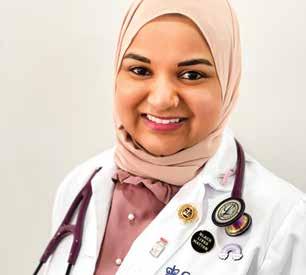






As the pandemic eases its grip, a changed world is regaining its feet. Columbia Nursing has changed, too, in ways that are explored in this issue’s features. We may have operated remotely for nearly two years, but we never stopped thinking about how to advance handson nursing education, research, and practice. Now back to in-person interactions, we continue to break barriers, challenge stereotypes, and defy expectations of what nursing is.
First and foremost, nursing is an equal-opportunity career. It is drawing record numbers of men, who want work that is impactful, well-paying, and intellectually and emotionally satisfying and that offers professional autonomy, growth, and flexibility. We witnessed the start of this trend back in the early 1970s, when we welcomed our first male students. Back then, only 3% of registered nurses in the United States were males, compared to today’s all-time high of 12%. What’s more, as noted in this issue’s cover story, our student body is now 14.1% male, up from 12.4% in 2017.
Not only are we graduating more nurses than ever who are male, but we are also preparing them—indeed, all our nurses—for career opportunities that defy traditional expectations of what nurses do. Yes, our graduates deliver the highest-quality care. They also teach, perform groundbreaking research, and run businesses. Some man age hospitals, like Paul Coyne, DNP ’16, senior vice president and chief nurse executive at the Hospital for Special Surgery. And others run nursing schools, like Jesus Casida, MS ’96, PhD, the Billingsley Professor of Nursing and executive director of the Eleanor Mann School of Nursing at the University of Arkansas.
To meet this surging interest in the field among men—and to wel come other populations historically underrepresented in nursing, including BIPOC (Black, Indigenous, and people of color) individu als—we have also relaunched and expanded our Men in Nursing group. After all, superior health education and care thrive on diver sity in the classroom and the clinic. They also require innovation, which calls for expanding the possibilities of what nurses can do.
Another change in our world is the growing impact of artificial intelligence (AI). You might not immediately think of AI when you think of nursing. But our nurse-scientists are redefining the field by devising AI apps that can improve patient care—as described in the second feature in this issue. These programs cull big data from elec
tronic health records (EHRs), including subtle patterns in nurses’ documentation when they are concerned about a patient’s impend ing downturn. One app displays a green, yellow, or red icon in a patient’s EHR to signal their estimated risk of deterioration in the next 12 hours. Clinicians can click on the icon to track a patient’s health status and determine if they need early intervention. Another app can prevent emergency department visits and hospitalizations by combing EHRs for nurses’ mentions of specific factors—anxiety, cognitive disturbance, depressed mood, fatigue, sleep disturbance, pain, or impaired well-being—that could represent early signs of a patient’s decline. There’s even an app that can detect patients’ immi nent health risks by analyzing their vocal mannerisms.
And the bioinformatics expertise that underlies AI apps like these is not only informing clinical care but also enriching nursing educa tion at Columbia.
So, too, are overseas clinical integration experiences for our Masters Direct Entry (MDE) students—the focus of this issue’s third feature. Clinical integration is a key requirement of our MDE program, and with our Office of Global Initiatives finally able to post students abroad again, for the first time in two years, we have already sent 49 students to 11 sites across the Caribbean, Africa, Asia, and Europe. There, our nurse-leader partners offer opportunities for our students to see the multiple ways nurses provide care and build health care systems and to observe how cultural values influence approaches to health, illness, birth, and death. Six students who recently returned from their place ments describe their newfound appreciation for the wealth of health care resources in the U.S. and explain how working in underresourced countries helped them to become better, more empathic clinicians.
Columbia’s dedication to advancing our field continually earns us top ranking among the nation’s nursing schools. We do more than prepare nurses. We prepare the providers of the future—who will be leaders as well as caregivers. We’re always pushing forward. We never stop.
FRAZIER,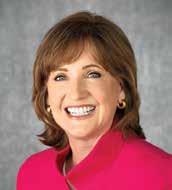 LORRAINE
PhD, RN, FAAN Dean, Columbia University School of Nursing Mary O’Neil Mundinger Professor of Nursing Senior Vice President, Columbia University Irving Medical Center
LORRAINE
PhD, RN, FAAN Dean, Columbia University School of Nursing Mary O’Neil Mundinger Professor of Nursing Senior Vice President, Columbia University Irving Medical Center
Lorraine Frazier, PhD, RN, FAAN
Dean, Columbia University School of Nursing
Mary O’Neil Mundinger Professor of Nursing Senior Vice President, Columbia University Irving Medical Center
ALUMNI NEWS EDITORS:
Janice Rafferty Grady
Assistant Dean, Development and Alumni Relations
Janine Handfus
Associate Director, Annual Fund
Sharon Sobel
Assistant Director, Alumni Relations
Columbia Nursing is the magazine of the Columbia University School of Nursing and is published twice a year
Produced by the Office of Strategic Communications and Marketing

Brenda Barrowclough Brodie, BS ’65 Durham, NC
Paul Coyne, DNP ’16, MBA
President & Co-Founder, Inspiren; Senior Vice President & Chief Nurse Executive, Hospital for Special Surgery New York, NY
Delphine Mendez de Leon, BS ’78, MBA, MPH
Chief Strategy Officer, University Hospital of Brooklyn New York, NY
Angela Clarke Duff, BS ’70 Forest Hills, NY
Marjorie Harrison Fleming, BS ’69 Chair Seabrook Island, SC
Susan Fox, BS ’84, MBA President & CEO, White Plains Hospital White Plains, NY
Susan Furlaud, MS ’12 Vero Beach, FL
Karen Hein, MD Jacksonville, VT
Mary Turner Henderson, BS ’64 San Francisco, CA
Linda Muskat Rim, Editor-in-Chief Senior Associate Dean, Strategic Communications and Marketing
DESIGN AND ART DIRECTION: Eson Chan
CONTRIBUTING WRITERS: Anne Harding
Andrea Kott Kenneth Miller
SENIOR COMMUNICATIONS COORDINATOR: Madeline Henry
·
·
·
Wilhelmina Manzano, MA
Senior Vice President, Chief Nursing Executive, & Chief Quality Officer, NewYork-Presbyterian Hospital & Regional Hospital Network New York, NY
Janet Ready, BS ’81, MBA, MPH
Chief Executive Officer, Community Health Centers of Lane County Assistant Director, Health and Human Services, Lane County Syracuse, NY
Patricia Riley, BS ’76, MPH Captain (Retired), U.S. Public Health Service Atlanta, GA
Susan Salka, MBA
President & CEO, AMN Healthcare San Diego, CA
Sara Shipley Stone, BS ’60, MS Brooksville, ME
Edwidge J. Thomas, DNP ’05
Vice President of Clinical Solutions, Northwell Holdings & Ventures New York, NY
Jasmine L. Travers, PhD ’16
Assistant Professor, NYU Rory Meyers College of Nursing New York, NY
Please address all correspondence to: press.nursing@columbia.edu
Alumni are invited to update their contact information by emailing sonalumni@columbia.edu or calling 212-305-5999
Subscribe to our monthly e-newsletter: nursing.columbia.edu
Like us on Facebook: @ColumbiaNursing
Follow us on Instagram: @columbianursing
Follow us on Twitter: @ColumbiaNursing
Follow us on LinkedIn: Columbia University School of Nursing
Subscribe to us on YouTube: Columbia University School of Nursing
An increase in the number of male nurses is dispelling stereotypes and breaking expectations.
Nurse researchers are harnessing artificial intelligence to help clinicians make better decisions—and protect patients from harmful bias.

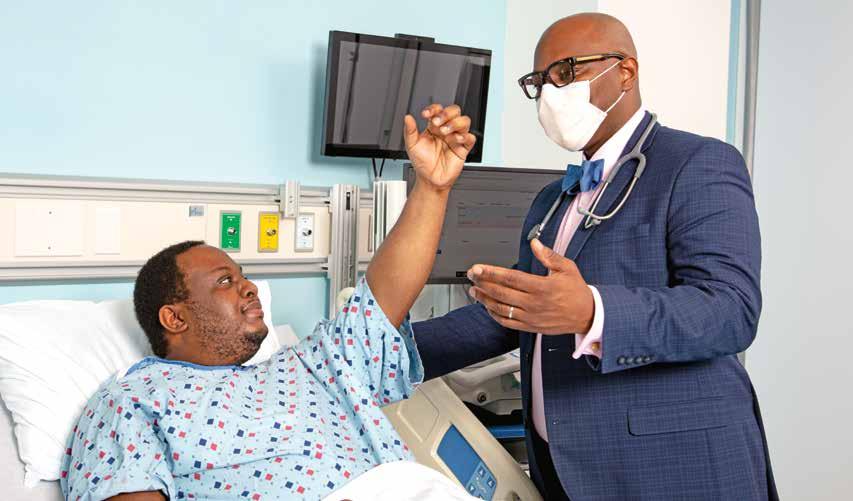
Global clinical placement program reopens after two-year hiatus.
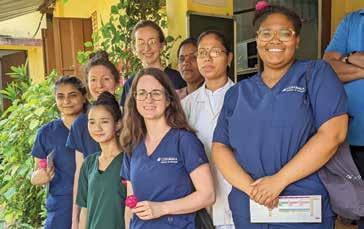
Associate Professor Kellie Bryant, DNP, has piloted an innova tive project for people who use drugs, to help them prevent injection-site infections and to encourage them to engage with the medical system.
Opioid overdose deaths jumped by 37% across New York City during the first year of the pandemic, notes Bryant, who is assistant dean of clinical affairs and medical director of Columbia Nursing’s Opioid Overdose Prevention program. The New York City Depart ment of Health, which Bryant frequently collaborates with, sought her help when they observed an increase in serious drug-related wounds, some so severe they required surgical treatment.
The Bronx Opioid Collective (BOC), another partner on the proj ect, sends peer outreach workers to the South Bronx three times a week, with the goal of reducing opioid-related deaths by motivating people to seek treatment, providing syringe exchange services, dis tributing Narcan, and handing out bag lunches. They reach about 300 people in a typical day.
Working with the BOC; the Department of Health; and the Aca cia Network, which provides community outreach to residents of the South Bronx, many of whom face housing instability, Bryant received funding to provide additional lunches, offer wound care education, and conduct a study on wound prevalence.

The pilot project’s goals were to identify the prevalence of sub stance use-related wounds in the South Bronx, provide people who use drugs with education on preventing and treating their wounds, and ultimately motivate those with severe wounds to seek treatment. The study, titled “Empirical Assessment of Drug-Related Wounds Among People Who Use Drugs: Pilot Testing a Standardized Wound Care Assessment and Referral Protocol,” received a $25,000 grant from CHOSEN (Columbia Center for Healing Opioid and Other Substance Use Disorders) in 2021. Bryant was its principal investi gator, and she had three co-investigators from Columbia University Irving Medical Center: Michael Chaple, PhD, an assistant profes sor of clinical medical psychology; Jermaine Jones, PhD, an associ ate professor of clinical neurobiology (in psychiatry); and Stephanie
Rozen, MS, director of addiction information and management strategies at Student Health on Haven.
From Feb. 28 to July 25, 2022, Bryant and three psychiatry DNP stu dents went out every Monday to do outreach alongside the BOC teams. The study participants received $10 for completing a survey, undergoing wound assessment, and receiving a wound care kit plus information on preventing infections. “We also provided wound care education to those that already had wounds,” Bryant explains. “We used motivational interviewing techniques to encourage those with more severe wounds to seek medical treatment.” The team completed 691 encounters.
“The first part was just establishing trust,” Bryant notes. “Some people we would see on a weekly basis, so we would see their wounds actually getting better.”
She is currently working on partnerships with other Columbia University investigators and funders to continue the project beyond the pilot stage; she plans to present the findings so far at an upcom ing Harm Reduction Conference. “There is a significant need to continue this work,” Bryant says. “People from this community are often stigmatized and do not receive the care that’s needed.”
DNP student Angela Cameron, MS ’21, was one of Bryant’s research assistants on the project. “My biggest takeaways from this placement were humility, consistency, transparency, reliability, and the importance of culture and language in our work as nurses and researchers,” she says. “It was heartwarming witnessing the improvement over time that a lot of the research participants made. I enjoyed the brief rapport and connections made with the people we served. Also, we had the luxury of witnessing in real time the benefits of harm reduction interventions on vulnerable populations.”
Cameron adds: “This experience highlighted the many cracks in our society that contribute to [such populations’] lived experiences. For me as a nursing student, this opportunity highlighted not only the importance of research and community outreach but the value of collaborative interdisciplinary teamwork and advocacy. Taking part in the research also sparked an interest in addiction services and harm reduction opportunities post-graduation.”
Most U.S. nursing homes have little or no capacity to communicate with external providers about patient care, according to a new survey by Columbia Nursing researchers.
“We identified important structural disparities in nursing homes (NHs) that are likely impacting the quality of care their residents are receiving,” conclude first author Gregory Alexander, PhD, the Helen Young CUPHSONAA Professor of Nursing, and co-authors Jianfang Liu, PhD, an associate professor, and Patricia Stone, PhD, the Centennial Professor of Health Policy, in an article published August 23 in JMIR Aging.
Health information technology (HIT) can help improve nursing home quality by providing clinicians with timely, secure access to patient information and improving care coordination, the authors note. But while 95% of NHs report using electronic health records, they add, the level of HIT adoption varies widely across facilities.
Alexander and his team looked at HIT maturity— a measurement of the use and integration of health information technology within resident care, clinical support, and administrative activities—in a sample of 719 nursing homes. They rated each facility’s HIT maturity stage from 0 (no HIT) to 6 (residents or their representatives can use the system to generate clinical data and drive self-management).
The study revealed that larger nursing homes and those in metropolitan areas had more mature HIT systems.
But most of the facilities (486, or more than 60%) were at HIT maturity stage 3 or lower, meaning they were not able to communicate electronically with staff from other facilities, such as outside clinics, labora tories, or pharmacies. “This lack of connectivity can result in reduced levels of electronic data sharing, leading to deficiencies in care delivery, substandard care-coordination activities, and poorer resident out comes,” according to the authors.
“These differences could be due to inadequate infra structures, availability of a knowledgeable workforce, or financial resources to promote higher levels of adoption,” the authors wrote. “It is crucial that we begin to consistently identify a means to address these disparities, first by increasing transparency and pub lic reporting about the trends in NH HIT maturity in the United States, followed by implementing national policies to level these deficits.”
Thirty national and international experts in the field of advanced nursing and health services research gathered at Columbia Nursing on June 27 and 28, 2022, for the Advancement of Research on Nurse Practitioners (ARNP) conference, hosted by the Center for Healthcare Delivery Research and Innovations and led by the center’s executive director, Lusine Poghosyan, PhD.
“ARNP brought together a group of interdisciplinary experts both from the U.S. and internationally to set a research agenda to study the growing NP workforce and barriers affecting their optimal practice in primary care,” Poghosyan said.

Along with Poghosyan—the principal investigator of this Agency for Healthcare Research and Quality-funded project and an expert in the NP workforce—the conference was co-chaired by Grant Martsolf, PhD, a pro fessor at the University of Pittsburgh School of Nursing and chair of nursing science at the University of Pittsburgh Medical Center Health System.
A committee of 11 leading experts from the U.S., U.K., Germany, and Canada joined the co-chairs in planning the conference. Policymakers, administrators, clinicians, and researchers from several countries, including Germany, the United Kingdom, and Israel, attended the meeting.
During ARNP’s four plenary sessions, subject matter experts delivered presentations on topics including:
1) NP workforce in primary care globally
2) Care of the underserved and NP workforce
3) Methodologies to study NP workforce and practice, and
4) New environments and roles: NP training and continuum of health care.
Following each plenary, participants self-selected into discussion groups and held robust conversations. On day two of the conference, attendees used the Delphi method to identify key questions to guide future research.
The expected product of the conference is a scholarly manuscript outlining a research agenda to enhance the NP workforce and primary care delivery by NPs in the U.S., which will be shared with nationally relevant organizations.
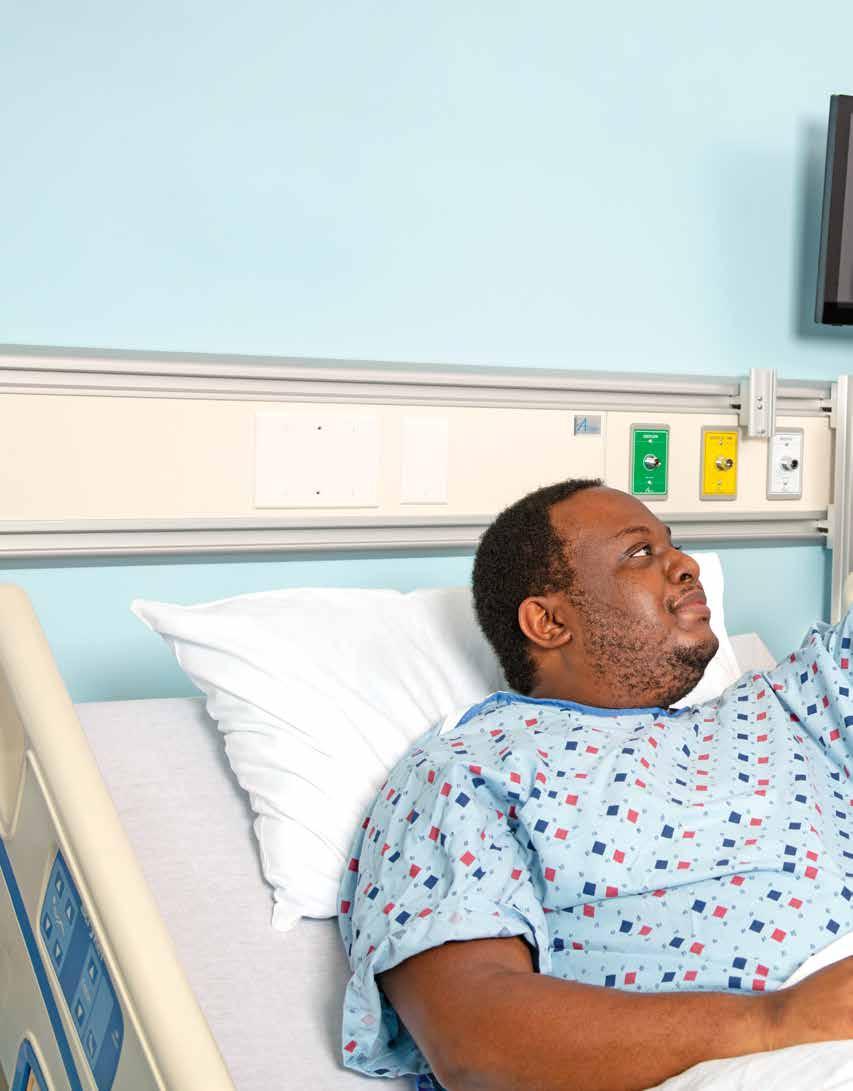 By Andrea Kott, MPH | Photographs by Jörg Meyer
By Andrea Kott, MPH | Photographs by Jörg Meyer
An increase in the number of male nurses is dispelling stereotypes and breaking expectations.Daniel Billings, DNP ’18 (right)

ello, doctor.” That’s how patients com monly greet Daniel Billings, DNP ’18, an infectious disease nurse practitio ner at Memorial Sloan Kettering Can cer Center in Manhattan. He earned his bachelor’s and master’s, as well as his DNP, from Columbia Nursing. But though he does hold a doctorate, Billings knows what these patients are think ing: “As soon as I enter a room,” he says, “people assume I’m the physician.”
Paul Coyne, DNP ’16, who also holds BS and MS degrees from Columbia Nursing, is senior vice president and chief nurse executive at the Hospital for Special Surgery (HSS), also in Manhattan. He encounters similar assumptions. “Peo ple ask, ‘Why didn’t you want to be a doctor?’” Coyne says. “They don’t realize that I am a doctor.” And, he adds, “Why don’t they ask my wife, who’s also a nurse, that question?
Do they ask their doctor why she didn’t want to be a nurse?”
Such gender-based stereotypes about who is—or should be—a nurse are all too common in the United States, where nearly 9 in 10 nurses are women. But the tenfold increase in the number of men in the field over the past 40 years, from 27,000 in 1977 to 310,000 in 2018, is gradually challenging these stereotypes. Today, the proportion of registered nurses who are male is at an all-time high of 12%, up from less than 3% in 1970. This has changed perceptions and definitions in what, along with teaching, was once considered a “women’s profession.” (The social science literature is replete with journal articles on that unfortunate, long-held assumption.)
The influx of men into nursing reflects many trends. Some are specific to nursing, including high turnover in the field and waves of retirements, which have depleted the nursing workforce and overburdened the health care system. Cycli cal economic slumps have played a role, too. There has also been an increased desire among men for work that is wellpaying, but also intellectually and emotionally satisfying, and that offers professional autonomy, growth, and flex ibility—all characteristics of a career in nursing. Another trend that has affected the gender balance in nursing is a growing awareness that diversity—including gender diver sity—in health care enhances both the caregiver and the patient experience.
According to the U.S. Bureau of Labor Statistics, there are some 3.9 million registered nurses in the U.S., approximately a million of whom are older than 50 and thus likely to retire in the next 10 to 15 years. Between impending retirements, the loss of nurses to COVID-related burnout, an aging pop ulation, and an increase in chronic illnesses, the need for nurses is higher than ever. In fact, employment opportuni ties for nurses are predicted to grow faster than those in any other occupation between 2016 and 2026.
Columbia Nursing, long known for its leadership in diver sity in both clinical nursing and nursing education, recog nized these trends decades ago. The school enrolled its first two men over 50 years ago—Ramón Lavandero, BS ’72, MS (also one of the school’s first Latino students), and John Mla dinich, BS ’72. Today, the student body of Columbia Nurs ing’s degree-granting programs is 14.1% male, compared to 12.4% in 2017, says Naveed Ahmad, director of stu dent life. The applicant pool for the school’s Masters Direct Entry (MDE) program was 13.4% male in 2022, compared to 11.7% in 2012 for the program’s precursor, Entry-toPractice (ETP). Those upturns, says Ahmad, are “a sign of men’s increasing interest in the field.”
To meet this interest, and the need for more nurses, the school recently relaunched the Columbia Men in Nursing group, which was originally formed in 2015 to encourage

men to join the field. The group, which now aims to become a nationally recognized chapter of the American Association for Men in Nursing, has expanded its mission to support personal and professional development for students, alumni, and fac ulty of all ages; to address men’s health issues; and to explore their unique contributions to the profession and the school, says the group’s leader and advisor, Don Boyd, PhD ’17, an assistant professor of nursing.
“Men are recognizing that nursing’s not a dead-end job,” says Boyd, a certified registered nurse anesthetist and the associate director of the school’s Nurse Anesthesia Program. Boyd became a registered nurse in 1995, at a time when it was considered an uncommon career choice for men. “When I told someone that I was in nursing school, they would say, ‘Oh, you’re becoming a male nurse,’” he recalls. “No one ever said, ‘I’m going to be a female nurse.’ You had to start tearing down barriers any time you talked about it.”
Boyd says he himself didn’t encounter barriers in the field, probably because his first nursing job was at a vet erans’ hospital, where most of his patients were men who were accustomed to receiving care from male medics. He also found easy acceptance among patients during his eight years working on a pediatric intensive care unit. “Kids are open-minded,” he says.

Passionate about clinical work, Boyd envisioned dedicat ing his entire career to direct caregiving. But the more he learned about the profession, the more he saw that nursing was not limited to bedside care, and the more interested he grew in the many opportunities the field offered. “There are nurses everywhere, throughout all industries, including business, research, and pharmaceutical development and sales, and they’re all doing amazing work,” he says. “Nurs ing is almost anything you can wrap your mind around doing professionally, including becoming a CEO of a highend company. In nursing, you have the ability to recreate yourself within the profession.”
The chance to recreate himself is exactly what drew Coyne to nursing after recovering from a thalamic stroke that he suffered at age 22, while working as a financial ana lyst at Goldman Sachs. “As my brain came back,” he says, “I wanted to see what parts of me were missing and what new parts I could find.” In addition, he wanted to dem onstrate his gratitude to the nurses who had painstakingly restored his health. The best way to do that, he decided, was to become a nurse so that he, too, could deliver com passionate, even lifesaving, care. “Nursing was something inside that was calling me,” says Coyne, who is now an adult-gerontology nurse practitioner. “In nursing, you work hard and can have the joy of knowing that you made a difference in someone’s life,” he observes.
Paul Coyne, DNP ’16
Paul Coyne, DNP ’16
Married and the father of a three-year-old son, Coyne says nursing gives him the flexibility to share childcare responsibility with his wife (and Columbia Nursing class mate), Danialle Calaustro Coyne, MS ’15, while providing him with a path to his current leadership post at HSS. “To those who say that a man’s role is to provide for his family, I say that nursing is a great career, with a starting salary that is on par with those in some areas of Wall Street,” Coyne says. “In nursing, you can do so many things—from working at the bedside to being a legal nurse-consultant to owning your own business. It’s just a good job.”
“Nursing is a great career,” Paul Coyne says. “You can do so many things—from working at the bedside to ... owning your own business. It’s just a good job.”
The desire to make a difference in people’s lives—especially at life’s end—is what led Billings, a former opera singer, to his nursing career. He found his initial inspiration while helping to care for a friend battling non-Hodgkin lym phoma. Observing and supporting his friend’s nursing care; providing respite care for his friend’s mother; and hearing his wife, who is a registered nurse, talk about her work experiences, moved him to leave his professional singing career so he could dedicate himself to helping others. “I’ve been the recipient of so much good, and I didn’t feel I was giving back to the world in the way I felt I needed to,” Bill ings says. “Nursing gave me that opportunity.”
Billings spent his early nursing years in Washington Heights, caring for patients with sickle cell disease at New York-Presbyterian Hospital. He soon realized that nursing entails more than hospital care. By teaching patients how
to take care of themselves at home and in the community and how to manage their diets and medications, he began to appreciate that he was able to make a real difference in their lives. “I saw myself in a lot of my patients,” says Bill ings, who is Black and grew up in a low-income, single-par ent household in Harlem. “Nursing isn’t just about treating patients in a hospital but helping them to live healthier lives,” he says. “By helping my patients, I feel that I’m giv ing back.”
Giving patients the information and compassion they need to take care of themselves is at the heart of excellent nurs ing care, says Stephen Ferrara, DNP, Columbia Nursing’s associate dean for clinical affairs. “One of the most impor tant things that providers can do for patients is to be close to them and to break down information so there’s no jar gon. That’s what nurses do,” explains Ferrara, who was just elected president of the American Association of Nurse Practitioners (AANP), the largest professional membership organization for nurse practitioners.
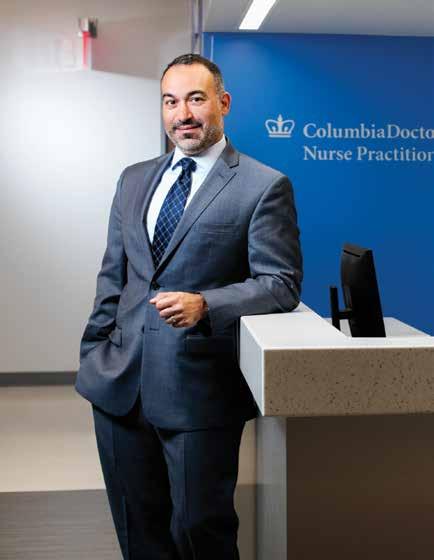
Although he acknowledges that women still predomi nate in the field, Ferrara considers it “an equal opportunity profession” that should look like the population it serves by having greater male representation. This is particularly important for patients who may feel more comfortable discussing male-specific health issues with nurses who are male, according to Ferrara. “We need to always think in terms of patient care.”
For example, some men may prefer having a nurse who is also a man when it comes to discussing prostate can cer, sexual dysfunction, or genitourinary conditions often associated with sexually transmitted infections, says DNP student Jaspreet Wadhwa, who is planning to be a family nurse practitioner. “Certain men may feel more comfort able talking about such sensitive and personal topics with a nurse who is also a man because there may be a greater level of understanding,” Wadhwa says.
Despite the rising number of men in the field, stereotypes remain, especially in some cultures that continue to regard nursing as a women’s profession, says Wadhwa, past presi dent of the Columbia Men in Nursing group. “A lot of men in nursing, especially those of color, can relate to that sentiment,” he says.
To get around this stigma, men sometimes choose to work in emergency rooms or on critical care units, areas that Ferr ara says are traditionally designated as “testosterone fields,” because they typically require intense, physical interventions. “We’ve seen nurses who had primary careers as firefighters or police officers end up in the ER or ICU,” he says.
By limiting themselves to these highly physical forms of nursing, however, men “skim the surface of what nurses can do and where they’re needed,” Ferrara notes. “We’re starting to move beyond that,” he says. “We’re seeing a shift now with people entering nursing as a primary career with a heightened awareness of how stable it is and all the different opportunities it offers,” he says. “If I was counsel ing any college student, I’d say, ‘Nursing is a career that offers lots of opportunity. It pays well, doesn’t lock you into one particular area, and gives you potential for growth.’”
Jesus Casida, PhD, who received his MS from Columbia Nursing in 1996, is a perfect example. Casida started his career in 1990 as a cardiac surgery ICU staff nurse and steadily discovered his passion for leadership, first in nurs ing practice and eventually in academia, science, and admin istration. “Cardiac surgery nurses have a lot of autonomy at the bedside and can use their advanced skills for complex decision-making,” he says. “When I saw how nurses could use these skills to help patients recover from major cardiac surgery, I realized the invaluable role of nursing and seized the opportunity to take on leadership roles,” says Casida, who is now the Billingsley Professor of Nursing and execu tive director of the Eleanor Mann School of Nursing at the University of Arkansas. “Nursing is a great profession,” Casida says, “and the opportunities are limitless. It is up to the individual to leverage what the profession can offer.”
Casida, who is also a new board member of Columbia Nursing’s Alumni Association, says that being male never dampened his fervor about nursing or influenced any of his professional choices along the way. “The essence of nursing is kindness and caring for other people,” he says. “If some one has those inherent values, then they will do very well in nursing. It doesn’t matter if you work at the bedside or in academia. If you don’t have basic caring and humanistic skills, then this profession is not for you.”
But the old fallacy that nursing is not for men has long been debunked. “Over the years, things have changed in terms of how men are viewed in the profession,” says Columbia Nurs ing’s Ahmad. “The stereotypes attached to nursing are dwin dling, so that however you identify, there’s a place for you.”
As the field continues to welcome more men, it is also open ing doors for other populations historically underrepresented in nursing, including BIPOC (Black, Indigenous, and people of color) individuals. “As nursing advances,” says Wadhwa, “it is becoming more inclusive and welcoming. As men, we understand that we are in a field where we’re not the majority or even equal in numbers, and we also understand that the best model of health care is having a diverse group of nurses, since we all bring something different to the table.”

Conveying this message is a top priority for Columbia Nursing, including through its reactivation of the Men in
Nursing group. However, Ferrara stresses, the group is not just for men. “Columbia Nursing is known as a school that welcomes everyone from everywhere,” he says. “Our goal is to bring people together and share a diversity of conversa tions, opportunities, and experiences. We want to see more male students, but we don’t want to have a solely male per spective. We welcome all genders and all races because we want to reflect the increasing diversity in nursing. That, for me, is the most important thing that I want to see come out of this group.”
As for Coyne, he’d like all stereotypes of who is or should be a nurse to end. “More people in the nursing pro fession, regardless of gender, make health care better,” he says. “I want the stereotype of nursing as woman’s work to be gone so we can all be nurses. We’re all human beings who care.”
Jesus Casida says that being male never dampened his fervor about nursing.
“The essence of nursing is kindness and caring for other people,” he says.
MS ’96, PhD
 BY KENNETH MILLER
BY KENNETH MILLER
he headlines about artificial intelligence, or AI, have become downright scary. AI technology, which is designed to mimic humans’ ability to solve complex problems using intuition and understanding, is getting frighteningly good at tasks once considered exclusive to Homo sapiens. AI programs can now create photorealistic artworks and write fluent book reviews. They can hold conversations so convincing that a Google engineer recently concluded the company’s language-modeling system had become sentient. Although most analysts rejected his claim (and he was fired after going public with it), such advances make many skilled workers worry that the bots are coming for their jobs.
Perhaps even more unnerving is how bad these programs can be at overcoming failings ingrained in their designers or data sources. One widely reported flaw is the tendency of AI tools to reflect a given culture’s common biases. Facial recognition programs often mistak enly identify people of color as criminals, for example. Credit-rating algorithms are all too likely to discriminate against Black loan applicants. Chatbots trained by interact ing with thousands of ran dom internet users can end up spewing racist, sexist, and anti-Semitic untruths.
early signals of patients’ impending decline by examining nurses’ documentation patterns in electronic health records (EHRs) and then create a predictive model that could form the basis for an AIdriven alert system.
In 2011, she enlisted a friend from her Columbia Nursing days— Kenrick Cato, PhD ’14—as co-principal investigator on a multisite study funded by the National Institute of Nursing Research. Ana lyzing EHRs for 15,000 acute care patients and 145 cardiac arrest patients over 15 months, the team found that the records for those who died had significantly more optional comments and vital sign checks by nurses over the 48 hours just before their death than did the records for those who survived—the first time such an associa tion had been shown.
FROM HARMFUL BIAS.
What gets less media attention, however, is some more encour aging news: AI can also be used to enhance the work of skilled professionals—including to fight bias in all its forms. At Columbia Nursing, researchers are pioneering such applications, harnessing the power of big data to improve outcomes for patients of every race, ethnicity, and gender.
“At its best, AI enables nurses to apply their knowledge and expe rience at the highest possible level,” says Sarah Rossetti, PhD ’09, an associate professor of bioinformatics and nursing. “It has the poten tial to transform the way we deliver care.”
That potential can be glimpsed in a tool that Rossetti herself has spent more than a decade developing—a clinical decision support system known as CONCERN (Communicating Narrative Concerns Entered by RNs). She conceived of it while working as a nurse infor maticist at Brigham and Women’s Hospital in Boston, after notic ing that nurses often changed their documentation habits when they were concerned about patients’ status long before their deterioration became evident on vital sign monitors. Rossetti hoped to identify
The researchers used AI techniques such as natural language pro cessing (which enables computers to understand text and spoken words) and machine learning (in which computers teach themselves to detect patterns in huge masses of data) to determine when early inter vention was warranted. Then the team devised an app, after consulting with clinicians on its design, that displays a col ored icon in a patient’s EHR: green for low risk of deterioration in the next 12 hours, yellow for increased risk, and red for high risk. Clinicians can click on the icon to see what factors determined the score and track the indi vidual’s status over time. “Our goal is to focus attention on patients in the yellow zone, who might not be on the care team’s radar yet,” explains Rossetti, who returned to Columbia Nursing as a faculty member in 2018.
She and Cato—who is now an assistant professor of nursing at the school—launched a clinical trial of CONCERN at Brigham and Women’s in early 2020; a second trial, delayed by the COVID-19 pandemic, began at NewYork-Presbyterian Hospital in August 2021. (Meanwhile, the team applied AI techniques they’d developed for CONCERN to help plan resource allocation for the COVID patients then flooding the hospital.) The results of those studies won’t be pub lished until later this year, but feedback from clinicians at both sites has been overwhelmingly positive.
In May, the team received a grant from the American Nurses Foun dation’s Reimagining Nursing Initiative to launch the next phase of their study: a trial of an implementation tool kit designed to support large-scale adoption of CONCERN. The researchers are partnering
ARTIFICIAL INTELLIGENCE TO HELP CLINICIANS MAKE BETTER DECISIONS—AND PROTECT PATIENTS
on that effort with three hospital systems—Mass General Brigham in Massachusetts, Vanderbilt University Medical Center in Tennessee, and Washington University School of Medicine/Barnes-Jewish Hospital in Missouri—to test the effectiveness of the tool kit in a variety of settings.
Far from threatening nurses’ jobs, Rossetti suggests, this AI-based app embodies the wisdom that makes them indispensable. “CON CERN shows what nurses already know: Our risk identification isn’t just a clinical hunch,” she says. “We’re demonstrating that nurses have objective, expert knowledge that drives their practice and brings tremendous value to the entire care team.”
Columbia Nursing researchers are also using AI to improve out comes for patients whose care takes place at home. Max Topaz, PhD, the Elizabeth Standish Gill Associate Professor of Nursing, is leading two such studies. The first, using an approach resembling CONCERN’s, aims to prevent emergency department visits and hos pitalizations among home care patients by analyzing nursing notes for early signs of a patient’s deterioration.
The challenges of finding such signs in a home setting are very dif ferent, however. “In the hospital, clinicians are present 24/7,” Topaz explains. “In home care, the interactions are a lot less frequent. A nurse might come to see a patient once every three or four days.” To detect danger signals under these conditions, an AI tool can’t rely on the frequency of nursing comments or vital sign checks, as the CON CERN app does; instead, it must seek out specific types of comments that indicate increased risk.
Topaz does such sleuthing using a natural language processing soft ware he invented himself, dubbed NimbleMiner, which can flag bits of meaningful data in hundreds of thousands of patient records at a time. Over the past two years, he and his team have used the program in conjunction with other AI tech niques to search for seven factors commonly associated with immi nent deterioration—anxiety, cogni tive disturbance, depressed mood, fatigue, sleep disturbance, pain, and impaired well-being—in 2.5 million home care records from the Visiting Nurse Service of New York. The system has proved capable of identifying those factors as accurately as human clinicians. The team is now working to design a tool that can alert clinicians in a user-friendly way to which patients are at height ened risk.
Topaz’s second home care-centered study aims to prevent rehos pitalization among newly discharged inpatients by helping home care nurses determine which patients need immediate care. Medicare requires that all patients receive a home visit within 48 hours of dis charge. For high-risk patients, however, waiting that long could be disastrous. But because EHRs don’t include risk data, visiting nurses have no way of knowing which patients to prioritize.
Topaz and his team developed an AI program called PREVENT (Priority for the First Visit Nursing Tool), which analyzes patients’
nursing records for five factors known to correlate with risk of rehos pitalization—sociodemographics, medication, depression, learning ability, and living arrangements. The tool then sends an email to each patient’s clinician, reporting its findings and recommending an expedited visit for those deemed high-risk. In a small pilot study published in 2018, the researchers found that when such patients received a nursing visit half a day sooner than those in a control group, they were far less likely to be readmitted. The team is now conducting a clinical trial, and results are expected to be published sometime next year.
“We’re building tools that can help standardize decision-making, but the last word always remains with the nurse,” says Topaz. “Our goal is for AI to function as an assistant—taking care of the bor ing administrative tasks so that nurses can focus more fully on their patients’ needs.”
Another possible target for AI tools is data that nurses don’t include in their notes. A postdoctoral fellow studying under Topaz, Jiyoun Song, PhD ’20, investigated the potential for identifying high-risk home care patients by analyzing their conversations with their nurses. In a pilot study led by Song, five nurses made audio record ings of their patient visits, 22 of which were typed up by a medical transcriptionist. The transcripts, and the nurses’ clinical notes, were then analyzed using a natural language processing tool.
Song and her team found that over 50% of health problems dis cussed during the home visits were not mentioned in the nurses’ EHR entries. “That’s a lot of missing information,” she says. “To do a better job of predicting patient outcomes, we really need to focus on those verbal communications.” A presentation that Song gave on this finding took first place in the “AI in Nursing” competition at the 20th International Conference on AI in Medicine this past June.
The next step for Song and Topaz will be using AI programs to ana lyze such conversations in real time, rather than waiting for transcripts to be completed. They also believe that patients’ vocal mannerisms could offer important data, beyond the content of their words. “Things like intonation, the number of pauses, the richness of vocabulary can all be revealing,” Topaz explains. “When people develop cognitive impairment or dementia, for example, their speech becomes more monotone. We can learn much more by captur ing not just what people say, but how they say it.”
Another disturbing aspect of Song’s study was the racial disparities it revealed. Among white patients, about 33% of problems discussed verbally went unrecorded in nurses’ notes; for Black patients, the proportion was twice as high—over 65%. Medication regimens were also recorded less frequently for Black than for white patients, and the average conversation was four minutes shorter for Black
“OUR GOAL IS FOR AI TO FUNCTION AS AN ASSISTANT ... SO THAT NURSES CAN FOCUS MORE FULLY ON THEIR PATIENTS’ NEEDS.”
patients. Although the sample size was too small to draw firm con clusions, it’s likely that the clinicians who participated in the study were not free of the biases found in society at large.
Such inequalities don’t surprise Kenrick Cato. “I recently worked on a paper with some colleagues where we were able to predict patients’ racial identity just by the content of the nursing notes,” he says. “We took out all the words that would denote race, but the differences in documentation patterns for Blacks and whites were unmistakable.”
Racial bias in AI can arise from several sources, Cato notes. One is a failure to ensure diversity in the data—for example, training a wound-identification tool mostly using photos of white patients’ lesions, so that it performs poorly when used with patients of color. Another common error is failing to recruit researchers from diverse backgrounds, who’d be likely to notice such shortcomings and cor rect them. “If you’re not careful,” Cato warns, “you’ll end up repro ducing pernicious biases that already exist and making them more powerful in the AI.”
But AI can also be a powerful tool for exposing bias and for pushing back against it. That’s what drew Veronica Barcelona, PhD, to the field, after two decades combating health care inequities by other means.

Barcelona, now an assistant professor of nursing at Columbia Nursing, began her career working on maternal mortality reduction in Latin America. She then pursued a PhD in epidemiology, with a focus on disparities in pregnancy and birth outcomes. As a postdoc at Yale, she studied under Jacquelyn Taylor, PhD, known for her work on the health impacts of racism and discrimination in minority populations. In January 2021, after Taylor joined Columbia Nursing as the Helen F. Petit Professor of Nursing, Barcelona followed her mentor to New York.
Soon, she began talking with Topaz and Cato about how AI tools could be used to examine the effects of racial bias in obstetrics—par ticularly, health care providers’ use of stigmatizing language in EHRs.
Previous studies had shown that clinicians’ notes can reveal uncon scious biases and stereotypes in the use of judgmental, skeptical, or even mocking language—such as “patient insists analgesic dosage is inadequate” or “patient claims smoking cessation but ashtray still noted on nightstand.” One paper had recently reported that physi cian notes about Black people were up to 50% more likely to con tain such language than those about white people. No one, however, had examined its prevalence specifically in obstetrics EHRs—or how it might affect pregnancy-related morbidity, which is significantly higher among people of color. With help from her new colleagues, Barcelona designed a study aimed at answering those questions.
In May, Barcelona won a grant from the Betty Irene Moore Fel lowship to pursue the groundbreaking project. (The study is also funded by Columbia University’s Data Science Institute.) She and her team will use tools such as NimbleMiner to analyze records from NewYork-Presbyterian Hospital between 2017 and 2019, examin ing language disparities by patients’ race and ethnicity, as well as by clinician type—nursing, social work, or medicine. They’ll look for associations between stigmatizing language and the incidence of infection, bleeding, or unplanned cesarean births.
Once the results are in, Barcelona hopes to develop interventions that can trigger change. “One possibility is to create programs that foster self-examination and discussions about how language reflects institutional values,” she says. “Another is to incorporate our find ings into educational curricula for nursing, medicine, and allied health. And I can imagine creating a software program that could be integrated into EHR systems, which would flag stigmatizing phrases and give clinicians a chance to say things differently.”
In the U.S., Barcelona adds, “white supremacy and structural racism have infiltrated every aspect of life, including the health care system. That’s a huge thing to try to dismantle, but if we can do it in one area, maybe the effect can spread. This is a chance to use AI for good.”
 BY ANNE HARDING
BY ANNE HARDING



When the world shut down in 2020 due to the COVID-19 pandemic, Columbia Nursing’s Office of Global Initia tives (OGI) was forced to suspend all its global clinical placements. In 2022, OGI faculty and staff celebrated the program’s reopening with a jubilant sendoff for 49 masters direct entry (MDE) students headed for clinical integration experiences at 11 sites across Africa, Asia, Europe, and the Caribbean; the students left on April 4 and returned on May 13.
Clinical integration experiences are a key requirement of the MDE program, with most students completing their integrations in or around New York City (for insight into a slightly further-afield clini cal integration option, see www.nursing.columbia.edu/news/country -roads). Many MDE students choose Columbia Nursing because of the scope of its global clinical opportunities, and members of this year’s class (as well as the OGI team) were thrilled to have them available once again.
“The reopening of the global clinical experiences program was such an exciting time,” says Jennifer Dohrn, DNP ’05, assistant dean for global initiatives. “It was exhilarating to watch our students finally being able to once again absorb and under stand the multiple ways that nurses are providing care and building their health care systems, as well as see first hand the devastating effects on people’s health from ineq uities and injustice globally.”
A unique aspect of Colum bia Nursing’s global clinical opportunities, Dohrn notes, is that the school’s program is guided by nursing leader ship in each country, with the stated purpose of understand ing nursing’s responsibility to reduce longstanding dispari ties and inequities in accessing the best health care.

“The students learn about different illnesses and their management, such as malaria and sickle cell anemia. This year, they witnessed the nursing response at their site to the COVID-19 pandemic, including the challenge to access COVID vaccines,” she adds. “They are immersed in many cultures and learn how different communities approach health, including birth and death. Overall, students tell us that they feel trans formed into committed nurses to be engaged globally.”
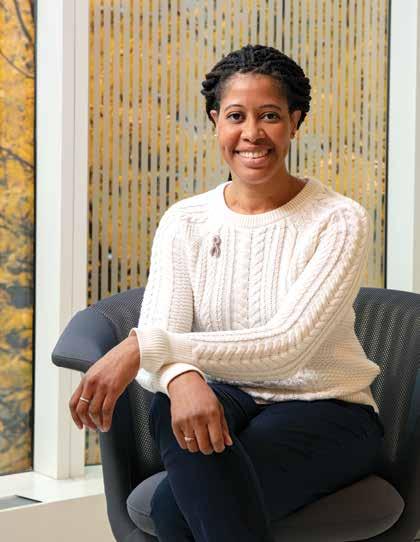
Natalie Voigt, PhD ’20, now an assistant professor at Colum bia Nursing, is the faculty liaison for the school’s program at the University of Nairobi, one of two clinical sites new in 2022. “It’s important for nurses to experience health care abroad,” she says,
“because it gives them perspective. I think immersive experiences abroad fundamentally change people for the better, and becoming an integral part of a foreign health care system will shape our stu dents into increasingly empathetic and competent clinicians. Their experience abroad will also give them a unique appreciation for the wealth of resources we have here in the U.S., and hopefully help them confront personal biases, uncon scious or otherwise. The experience can’t help but make better nurses.”
The OGI team is now preparing for its 2023 global clinical place ments, which will include new sites and bring back others—for example, Spain—that couldn’t host students in 2022 due to international travel and work restrictions. They will also hold two town halls to introduce the sites to students. “The students who went are the best ambassadors for the program,” Dohrn notes.
Here, six students from the first class to go back out in the field talk about why they chose the global option, what they learned, what surprised them, and more.
Voigt, PhD ’20
“Students tell us that they feel transformed into committed nurses to be engaged globally.”
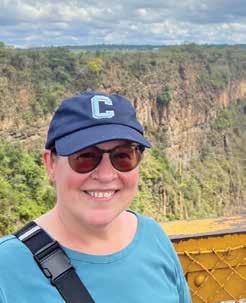
Mary Ellen Morris-Delaney came to nursing from a career as a cer tified public accountant. Her work in finance began in the private sector and then continued with global nonprofits. During her clinical integration in Zambia—at University Teaching Hospital, the main hospital in the country’s capital, Lusaka—she was struck by the strong collaboration among nurses, physicians, occupational thera pists, physical therapists, and others who cared for the patients.
This interprofessional approach to health care is developing in the U.S., but in Zambia, it’s intrinsic because it’s just what they do. In Zambia there’s a ward, the health records are shared, and they’re all paper. I could engage with the phy sicians when they did their rounds, read the chart to understand the history of the patient fully so I could ask questions, and with that understand more about the care they prescribed, thereby becoming more a part of the conversation.
The first couple of weeks I worked on the internal medicine women’s ward, car ing mainly for heart failure patients. The next week, I was in the community doing household surveys with thirdyear medical students. Then the last couple weeks, I was in the medsurgical step-down unit, on the men’s ward, caring for patients with serious wounds.
The nurses were always interacting with the entire health care team, not just doing what was written in the care plan by the physi cians but actually working together to improve the overall health of the patients.
It was also amazing to see how creative people could be, and how efficient given the limited resources available. I liked that, too, because it showed me that if I could do this without relying on tech nology, I can trust my skills, I can trust my training.
Bel-Air Hospital opened in the mountain resort town of Panchgani, India, as a tuberculosis sanitorium in 1912, when fresh air and rest were among the only treatment options for TB patients. The hospi tal continues to care for TB patients and was also among the first in the country to admit HIV patients (who are at higher than usual risk
of TB), providing them with effective treatment. Serving her integra tion at this unique site, Kimberly St Fleur was impressed to see how patients and their families had built a healing community.
It’s a miraculous place, honestly, just its history and the way that it’s dedicated to serving people, especially in India, where the stigma against HIV and TB is still very prevalent, especially in pri vate medical settings, which are thought to provide better care.
The clinical experience was very informative. TB is not a huge prob lem in the U.S., but it is pretty common in India. We’re basically learn ing from scratch all about TB—as well as TB drugs and treatment and TB testing and diagnostics—and also the history of tuberculosis in India and the national programs that the Indian government has implemented to control tuberculosis and the response to them.

For many of the patients that we met, Bel-Air was their last chance, and because of that, and the acceptance and the community that’s been built there, people don’t want to leave. They want to stay, they want to give back and serve.
Toward the end of my placement, a patient who had been there since we’d arrived was finally going home. On the day she was dis charged, it was amazing to see all the different patients and patients’ families coming from her unit and other units, all helping her pre pare to leave, almost like a parade or celebration. It was surreal for me to see that, wow, this is truly a community that’s been built between these patients and their families. And Bel-Air intentionally gives people the space for that.
understand that. It’s better to try and bring the husband on board than try to say, “The patient has given consent, and we’ll do whatever the patient wants.” You might save the patient at that time, but they might go home and die from something else, like neglect or a divorce.
Bay Area native Nadeen Eliyan grew up spending summers visit ing extended family in Palestine. When she signed up for Columbia Nursing’s program at the University of Jordan in Amman, she hoped to hone her already-fluent Arabic and learn more about how the language is used in medicine.

We were there during the month of Ramadan and Eid. We worked with the master’s students there, and it was special to feel this togeth erness—we’re learning together, we’re fasting together. They took us under their wings, inviting us to dinners, inviting us to the other hospitals that they worked at. Learning beside them was really, really awesome. The depth of knowledge that they had was admirable.

After studying psychology in his native Ghana, moving to the U.S., and working for a couple of years as a certified nurse assistant, Godfred Boampong decided he wanted to be able to provide more advanced care to patients. He was excited to travel back to Ghana for his clinical integration at St. Anthony’s Hospital, especially after learning the trip would take place in April, when he usually goes home to visit his wife and celebrate their anniversary.
Everything was new and a learning opportunity for me. I think what really helped me was the fact that I grew up there, which gave me insight into the culture and the health care system.
My experiences emphasized the need for nurses that are culturally understanding and empathetic. For example, a woman was about to undergo an emergency C-section, when another doctor ran in and told them to stop right away. While the woman had consented, her husband had phoned in and said he did not want his wife to have a C-section.
The patient might decide that “I don’t want to do it, because my husband doesn’t support it,” and we might not understand why she’s making that decision, and it takes a culturally competent nurse to
I consider myself quite fluent in Arabic, but when you’re thrown in there and that’s all they’re speaking, you realize, “Oh, wow. I don’t know as much as I thought I did and there are limits.” As the translator for my peers, I was trying to translate English to Arabic and Arabic to English, but a lot of these things don’t have direct translations, or I just didn’t know the direct translation. So that was also a tricky spot to be in and added another layer.
I did my best in trying to translate not just language, but also cultural values. I felt like I took on a special role of trying to explain a lot to each side, which was interesting for me. And it was challenging for me at times to feel like I had that weight of being in this role for both parties.
One of my main goals in participating in the global experience was to see health care from a non-Western perspective, and how culture influences health care. Throughout this experience, I was reminded to always go into things with an open mind, always ask and not assume, always really try to understand somebody’s cul tural values before you make broadening assumptions, because peo ple’s ideas and health literacy and how they interact with their own health care experience—all of that is so greatly influenced by culture.
Kaoru Suzuki Houghton spent more than 15 years as an educational pro gram specialist for the United Nations and other nongovernmental orga nizations overseas, then a few years in the U.S. as a full-time mom (she and her husband now have four children), before deciding she wanted to work more directly with people. She settled on nursing and applied only to Columbia Nursing, motivated by the school’s global clinical opportu nities. She says her placement at Kamuzu Central Hospital in Lilongwe, Malawi, underscored how much more she needed to learn in terms of nursing skills and knowledge, but also offered invaluable lessons on pro viding patients with respectful care and advocating for their needs.
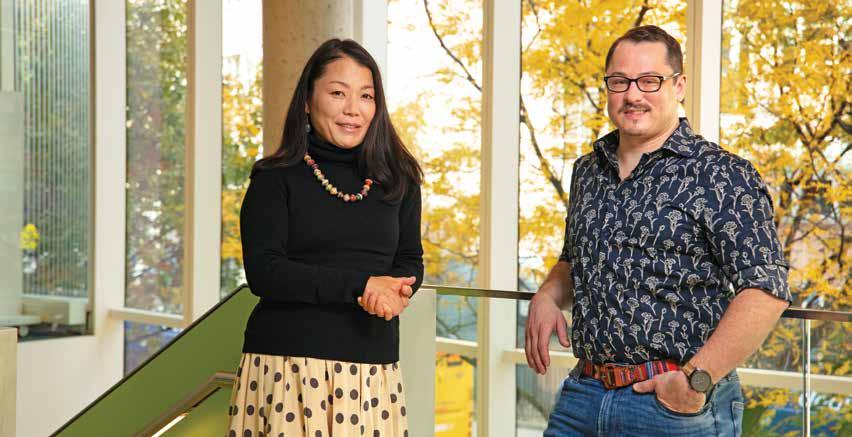
When I first arrived at the hospital, I felt immediately overwhelmed. The ward was overcrowded with high-acuity patients, while facing a severe lack of medical resources, including a scarcity of supplies. Because of the lack of physicians and nurses, there was not enough time or personnel to respond to the emotional needs of families about their loved ones’ impending deaths. With a mix of expectation and anxiety, I jumped in to do what I could.
Throughout my clinical experience in Malawi, I learned and prac ticed the important role of the nurse as patient advocate at a deep level. For example, one of my patients could not be saved due in part to a blood shortage. It was an indescribable thing to accept that we could not save her life.
The physician appreciated that I had called for medical attention for my patient, and told me that physicians can respond to patients quickly only when nurses alert them to changes or abnormalities. While I could not save her life, I was proud to stand up for my patient and be her advo cate. I was proud of myself and my colleague for finding something, even a very little thing like cleaning her body, to protect her dignity. I will never forget this patient, because she made me become a true patient advocate.
After more than a decade as a modern dancer in New York City, Jacob Szczypek decided to return to his premed dream of becoming a practitioner providing affirming health care—this time around, as a nurse midwife. He chose his placement at American Interna tional University of West Africa in Banjul for its focus on mater nal care and midwifery. While male midwives remain rare in the U.S., they are common in many other parts of the world, including The Gambia.
Learning how scary it can be to give birth in the U.S., and about the lack of holistic, compassionate care, really inspired me to become someone who could provide that for people. It’s heartbreaking to hear about the number of preventable maternal deaths and neonatal deaths that occur, especially in such an advanced country.
During my placement, I spent a week on the postpartum ward and then moved to the labor ward the second week. I was able to spend time at the bedside with the patients, helping them in a very tangible way.
I also saw several surgeries, including bilateral tubal ligations, C-sections, ectopic pregnancy surgery, and uterine fibroid removals. The range of exposure that I had was just incomparable. I don’t know if I would ever be able to have that experience here in the U.S., in that short amount of time.
I think it’s important that men and male-identifying individuals become educated on birth and maternal care and the importance of it. For me, in my experiences so far, I can provide and offer just as adequate care as any other person going into the field. It’s about passion and care. It’s something that I think is the most miraculous, amazing part of human biology, the way we reproduce. It’s how we all come into life. To me, it’s not gendered.
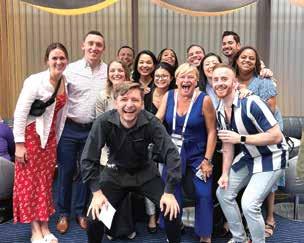

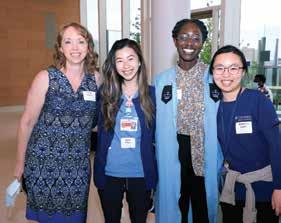


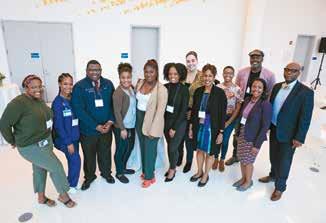


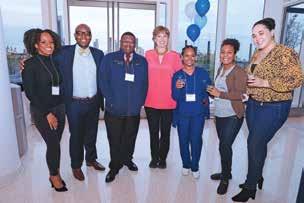
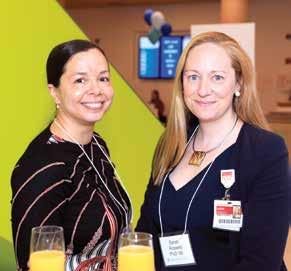
1: Michaela Rahimi DNP ’21, Rachael Mignin DNP ’21, and Mary Moran MS ’08, instructor in nursing, at the Classes of 2020 and 2021 Graduation Celebration.
2: Olivia Velez PhD ’11 and Sarah Rossetti PhD ’09, assistant professor of biomedical informatics, at Alumni Reunion.

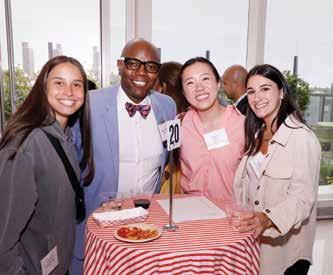
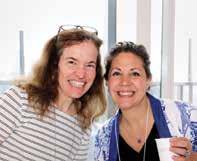
3: Jaime Panton, assistant professor, Sarah Phan MS ’20, Tia Kellman MS ’20, and Sharon Chen MS ’20 at the Classes of 2020 and 2021 Graduation Celebration.
4: Hope Ledig DNP ’21, Alexandra Brown DNP ’21, and John Raterman DNP ’21 at the Classes of 2020 and 2021 Graduation Celebration.
5: 130th Anniversary Toast with Dean Lorraine Frazier at Alumni Reunion.
6: Anesthesia alumni gathering for a networking social at the American Association of Nurse Anesthesiology Annual Congress.
7: Cameryn Lacey MS ’21, Alexis Richardson, Michael Ballard, Brittany Taylor, Shangyne Samuels MS ’21, Danielle Wright MS ’20, Lauren DeVaughn MS ’21, Kellie Bryant, associate professor, Kaycie Hutcheson MS ’21, Kenrick Cato PhD ’14, assistant professor, Felesia Bowen PhD ’10, and Daniel Billings DNP ’18 at the Black Student and Alumni Mixer.
8: Maureen Murphy-Ruocco MS ’80, Karen Desjardins DNP ’05, Felesia Bowen PhD ’10, Meghan Reading Turchioe PhD ’18, Pamela de Cordova PhD ’11, Po-Yin Yen PhD ’10, and Ann-Margaret Navarra PhD ’11 at the Alumni Awards Ceremony.
9: Rita Spindola BS ’72 and Gaily Thomson BS ’72 at Alumni Reunion.

10: Danielle Wright MS ’20, Daniel Billings DNP ’18, Michael Ballard, Dean Lorraine Frazier, Alexis Richardson, Brittany Taylor, and Lauren DeVaughn MS ’21 at the Black Student and Alumni Mixer.
11: Daniel Billings DNP ’18 with new students at New Student Orientation Trivia Night.

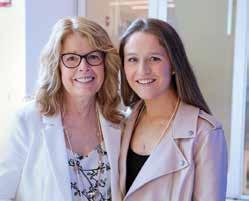
12: Kenice Kenlock MS ’20, Christina Noel MS ’20, and Tka Edwards MS ’20 at Alumni Reunion.
13: Sue Hawes BS ’59, Penny Buschman BS ’64, and Joan Arnold BS ’69, Anna Maxwell Award Recipient, at Alumni Reunion.
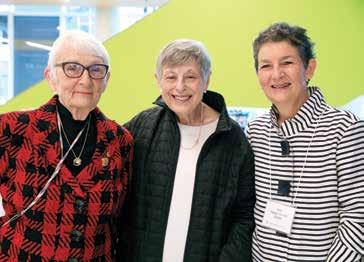
14: Kevin Browne MS ’92 and Christa Heinsler BS ’76 at Alumni Reunion.
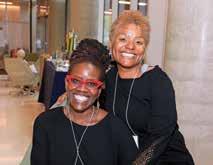
15: Sue Doyle-Lindrud DNP ’08, associate professor, and Laura Ardizzone DNP ’10 at Alumni Reunion.
16: Denise Pollard PhD ’06 and Rhonda Brockington MS ’03 at Alumni Reunion.
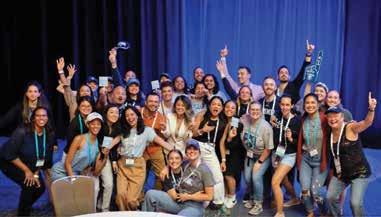
17: Anesthesia alumni celebrating a Columbia victory at the Anesthesia College Bowl at the AANA Annual Congress.
18: Mother-daughter duo Una Doody BS ’82 and Jacqueline Doody at Alumni Reunion.
19: Melissa Gray MS ’22 and William Swanson MS ’22 at Alumni Reunion.
Principal Investigator: Gregory Alexander, PhD
Project Title: A National Report of Nursing Home Quality Measures and Information Technology R01HS022497
Program Funding Source: AHRQ Total Budget: $742,785

Project Dates: 3/1/2020 - 7/31/2023
Principal Investigator: Adriana Arcia, PhD
Project Title: Validity of Functional Assessment Staging by Caregivers
AARGD-20-684358
Program Funding Source: Alzheimer’s Association Total Budget: $149,938 Project Dates: 8/1/2020 - 8/1/2023
Principal Investigator: Adriana Arcia, PhD
Project Title: Validity of Functional Assessment Staging by Caregivers
AARGD-20-684359-Supplement
Program Funding Source: Alzheimer’s Association
Total Budget: $49,618 Project Dates: 2/1/2021 - 10/31/2021
Principal Investigator: Suzanne Bakken, PhD
Project Title: Precision in Symptom Self-Management Center (PriSSM) P30NR016587
Program Funding Source: NIH-NINR Total Budget: $2,722,457 Project Dates: 8/16/2016 - 5/31/2022
Principal Investigator: Suzanne Bakken, PhD Project Title: Reaching Communities Through the Design of Information Visual izations (ReDIVis) Toolbox for Return of COVID-19 Results P30NR016587-05S1
Program Funding Source: NIH-NINR Total Budget: $1,252,027 Project Dates: 11/16/2020 - 11/15/2022
Principal Investigator: Suzanne Bakken, PhD Project Title: Reaching Communities Through the Design of Information Visu alizations (ReDIVis) Toolbox to Address COVID-19 Vaccine Hesitancy and Uptake P30NR016587-05S2
Program Funding Source: NIH-NINR Total Budget: $284,499 Project Dates: 8/10/2021 - 7/31/2023
Principal Investigator: Suzanne Bakken, PhD Project Title: Reducing Health Dis parities Through Informatics (RHeaDI) T32NR007969
Program Funding Source: NIH-NINR Total Budget: $1,939,614 Project Dates: 7/1/2017 - 6/30/2022
Principal Investigator: Suzanne Bakken, PhD Project Title: Reducing Health Dis parities Through Informatics (RHeaDI) T32NR007969-19S1
Program Funding Source: NIH-NINR (NHGRI Supplement)
Total Budget: $170,807 Project Dates: 7/1/2020 - 6/30/2022
Principal Investigator: Melissa Beauchemin, PhD Project Title: Children’s Oncology Group NCORP Research Base UG1CA189955
Program Funding Source: NIH-NCI (Chil dren’s Hospital of Philadelphia Subcontract) Total Budget: $15,508 Project Dates: 8/1/2020 - 7/31/2021
Principal Investigator: Melissa Beauchemin, PhD Project Title: Symptom Screening Linked to Care Pathways for Children with Cancer: A Cluster Randomized Trial R01CA251112 Program Funding Source: NIH-NCI (Hospi tal for Sick Children Subcontract)
Total Budget: $34,053 Project Dates: 8/1/2020 - 4/30/2025
Principal Investigator: Melissa Beauchemin, PhD Project Title: Children’s Oncology Group NCI Community Oncology Research Pro gram (NCORP) Research UG1CA189955 Program Funding Source: NIH-NCI (Public Health Institute Subcontract)
Total Budget: $15,665 Project Dates: 8/1/2021 - 7/31/2022
Principal Investigator: Melissa Beauchemin, PhD Project Title: Spanish Validation of the Per sonal Financial Well-Being Scale Program Funding Source: COG Nursing Discipline (work order still pending) Total Budget: $15,000 Project Dates: 3/1/2022 - 2/28/2023
Principal Investigator: Melissa Beauchemin, PhD Project Title: Underserved Site NCI Com munity Oncology Research Program UG1CA189960 Program Funding Source: NIH-NCI (through the cancer center) Total Budget: $33,332 Project Dates: 8/1/2021 - 7/31/2022
Principal Investigator: Walter Bockting, PhD Project Title: Gender Affirmation, Quality of Life, and Access to Care: A Mixed-Method Longitudinal Investigation R01NR019315 Program Funding Source: NIH-NINR (Visiting Nurse Service of New York Subcontract)
Total Budget: $1,271,390 Project Dates: 7/1/2021 - 4/30/2026
Principal Investigator: Jean-Marie Bruzzese, PhD
Project Title: Translating an EvidenceBased Urban Asthma Program for Rural Adolescents: Testing Effectiveness and Cost-Effectiveness and Understanding Factors Associated with Implementation R01HL136753
Program Funding Source: NIH-NHLBI Total Budget: $3,620,591 Project Dates: 7/5/2017 - 6/30/2023
Principal Investigator: Jean-Marie Bruzzese, PhD
Project Title: Peer-Administered Asthma Self-Management Intervention in Urban Middle Schools R01MD012225
Program Funding Source: NIH-NIMHD (Rhode Island Hospital Subcontract) Total Budget: $136,006 Project Dates: 9/25/2017 - 6/30/2022
Principal Investigator: Jean-Marie Bruzzese, PhD
Project Title: Development and Pilot Test ing of Sleeping Healthy/Living Healthy: A Comprehensive Sleep Intervention for Ado lescents in Urban SBHCs R21MD013991 (Multiple PI: Samantha Garbers [Contact]) Program Funding Source: NIH-NIMHD Total Budget: $459,766 Project Dates: 8/3/2020 - 2/28/2023
Principal Investigator: Jean-Marie Bruzzese, PhD
Project Title: The Efficacy of CAMP Air, a Web-based Asthma Intervention, Among Urban Adolescents with Uncontrolled Asthma R61HL151958-01A1
Program Funding Source: NIH-NHLBI
Total Budget: $819,279 Project Dates: 7/7/2021 - 6/30/2022
Principal Investigator: Kellie Bryant, DNP
Project Title: Hearst Simulation Lab Pro posal HEARSTCU19-2045
Program Funding Source: William Randolph Hearst Foundation Total Budget: $500,000 Project Dates: 7/1/2019 - 6/30/2022
Principal Investigator: Billy Caceres, PhD
Project Title: Examining Associations of Sexual Identity, Life Experiences, and Cardiovascular Disease Risk in Sisters K01HL146965
Program Funding Source: NIH-NHLBI Total Budget: $854,887 Project Dates: 7/1/2019 - 6/30/2024
Principal Investigator: Kenrick Cato, PhD Project Title: Communicating Narrative Concerns Entered by RNs (CONCERN) R01NR01694101 (Multiple PI: Sarah Rossetti [Contact])
Program Funding Source: NIH-NINR Total Budget: $2,415,488 Project Dates: 5/1/2018 - 1/31/2022
Principal Investigator: Kenrick Cato, PhD Project Title: Homecare-CONCERN: Build ing Risk Models for Preventable Hospital izations and Emergency Department Visits in Homecare R01HS027742
Program Funding Source: AHRQ (VNSNY Subcontract)
Total Budget: $23,352 Project Dates: 9/30/2020 - 7/31/2024
Principal Investigator: Kenrick Cato, PhD Project Title: IMProving Outcomes Related to Patients Through Advanced Nursing Technology (IMPORTANT) R03HS027006
Program Funding Source: AHRQ (RF-CUNY Subcontract)
Total Budget: $4,050 Project Dates: 4/1/2020 - 3/31/2022
Principal Investigator: Leah Estrada, BSN Project Title: Health Policy Research Scholars Cohort Four 2020 RWF77840
Program Funding Source: RWJF Total Budget: $124,000 Project Dates: 9/1/2020 - 8/31/2024
Principal Investigator: Leah Estrada, BSN Project Title: Racial/Ethnic Differences in Pal liative Care Services and Potentially Avoidable Hospitalizations at End-of-Life in Nursing Homes Nationwide F31NR019519-01A1
Program Funding Source: NIH-NINR Total Budget: $56,048 Project Dates: 7/1/2021 - 10/31/2022
Columbia Nursing Fall-Winter 2022
Principal Investigator: Stephen Ferrara, DNP Project Title: HRSA Advanced Nursing Education Nurse Practitioner Residency (ANE-NPR) Program BASSETTCU19-0741 Program Funding Source: HRSA (Bassett Subcontract)
Total Budget: $353,672 Project Dates: 7/1/2019 - 6/30/2023
Principal Investigator: Stephen Ferrara, DNP Project Title: Advanced Nursing Edu cation Nurse Practitioner Residency Integration Program (ANE-NPRIP) CHCNTWKCU20-1905
Program Funding Source: HRSA (Commu nity Healthcare Network Subcontract)
Total Budget: $327,808 Project Dates: 9/1/2020 - 8/31/2023
Principal Investigator: Lorraine Frazier, PhD Project Title: Jonas Nursing and Veter ans Healthcare at Columbia University JCHCU16-0569
Program Funding Source: Jewish Communal Fund/Jonas Nursing and Veterans Healthcare Total Budget: $11,082,858 Project Dates: 12/28/2017 - 12/27/2027
Principal Investigator: Lorraine Frazier, PhD Project Title: Ladies Christian Union (LCU) Fund for Women’s Education LCUCU21-0131
Program Funding Source: Ladies Christian Union (LCU) Total Budget: $110,000 Project Dates: 7/1/2021 - 6/30/2022
Principal Investigator: Lorraine Frazier, PhD Project Title: Dr. Scholl Foundation Scholarship Fund SCH0LLCU20-0745 Program Funding Source: Dr. Scholl Foundation Total Budget: $10,000 Project Dates: 1/1/2021 - 12/31/2021
Principal Investigator: Lorraine Frazier, PhD Project Title: Dr. Scholl Foundation Scholar ship Fund SCH0LLCU21-0680
Program Funding Source: Dr. Scholl Foundation Total Budget: $10,000 Project Dates: 10/7/2021 - 10/6/2022
Principal Investigator: Maureen George, PhD Project Title: BREATHE: An Efficacy-Imple mentation Trial of a Brief Shared DecisionMaking Intervention Among Black Adults with Uncontrolled Asthma in Federally Qualified Health Centers (FQHC) R01NR019275
Program Funding Source: NIH-NINR Total Budget: $2,447,470 Project Dates: 5/6/2020 - 2/28/2026
Principal Investigator: Maureen George, PhD Project Title: The Development and Pilot Testing of a Caregiver-Child Shared Decision-Making Intervention to Improve Asthma in Urban Youth R21NR01966801A1 (Multiple PI: Jean-Marie Bruzzese)
Program Funding Source: NIH-NINR Total Budget: $415,738 Project Dates: 7/28/2021 - 6/30/2023
Principal Investigator: Amanda Hessels, PhD Project Title: Simulation to Improve Infection Prevention and Patient Safety: The SIPPS Trial R18HS026418
Program Funding Source: AHRQ Total Budget: $1,860,798 Project Dates: 3/1/2019 - 2/29/2024
Principal Investigator: Vaneh Hovsepian, PhD Project Title: The Influence of Primary Care Structural Capabilities on Hospitaliza tions Among Older Adults with Dementia R36AG071946
Program Funding Source: NIH-NIA Total Budget: $48,191 Project Dates: 6/15/2021 - 2/28/2022
Principal Investigator: Tonda Hughes, PhD Project Title: Impact of Supportive Policies on Minority Stress, Drinking, and Health Among Women R01AA013328
Program Funding Source: NIH-NIAAA (Uni versity of Illinois at Chicago Subcontract) Total Budget: $958,320 Project Dates: 2/1/2017 - 7/31/2021
Principal Investigator: Tonda Hughes, PhD
Project Title: Impact of Supportive Policies on Minority Stress, Drinking, and Health Among Women R01AA013328-14S1
Program Funding Source: NIH-NIAAA (University of Illinois at Chicago Supplement Subcontract)
Total Budget: $41,521 Project Dates: 8/1/2021 - 7/31/2022
Principal Investigator: Tonda Hughes, PhD
Project Title: Sexual Orientation Differences: Prevalence and Correlates of Substance Use and Abuse R01DA036606
Program Funding Source: NIH-NIDA (Public Health Institute Subcontract)
Total Budget: $137,725 Project Dates: 2/1/2017 - 8/31/2021
Principal Investigator: Tonda Hughes, PhD Project Title: Stress, Hazardous Drink ing, and Intimate Partner Aggression in a Diverse Sample of Women and Their Part ners R01AA027252
Program Funding Source: NIH-NIAAA Total Budget: $2,750,690 Project Dates: 9/10/2019 - 6/30/2024
Principal Investigator: Betina Idnay, BSN Project Title: Improving Eligibility Pre screening for Alzheimer’s Disease and Related Dementias Clinical Trials with Nat ural Language Processing R36HS028752 Program Funding Source: AHRQ Total Budget: $20,767 Project Dates: 1/1/2022 - 3/31/2023
Principal Investigator: Haomiao Jia, PhD Project Title: Mental Health Burden on the U.S. Population, including Workers in the Wake of the COVID-19 Pandemic 20IPA2014150-M01 Program Funding Source: DHHS-CDCNIOSH-SSTRB
Total Budget: $100,000 Project Dates: 9/1/2020 - 8/31/2023
Principal Investigator: Laura Kelly, PhD Project Title: BHWET Interprofessional Col laborative Practice Model MC1HP42105-01 Program Funding Source: HRSA Total Budget: $1,919,907 Project Dates: 7/1/2021 - 6/30/2025
Principal Investigator: Maribeth Massie, PhD Project Title: Nurse Anesthetist Traineeships A22HP33098 Program Funding Source: HRSA
Total Budget: $183,297 Project Dates: 7/1/2020 - 6/30/2023
Principal Investigator: Shazia Mitha, MSN Project Title: Breast Cancer and Cardiotoxicity Program Funding Source: American Cancer Society Total Budget: $30,000 Project Dates: 9/1/2020 - 8/31/2022
Principal Investigator: Nicole Napolitano, MS Project Title: Improving Pediatric Mental Health Through Primary Care and Psychi atric Mental Health Collaboration: An Inte grative Review of the Literature SI-22-001 (Multiple PI: Anastasia Aguiar) Program Funding Source: Arnold P. Gold Foundation Total Budget: $1,600 Project Dates: 3/1/2022 - 5/31/2022
Principal Investigator: Allison Norful, PhD Project Title: Optimizing the Use of Primary Care Provider Workforce During Chronic Disease Care: The Measurement and Impact of Provider Co-Management RFUCU18-1324 Program Funding Source: RFU Total Budget: $25,000 Project Dates: 7/1/2018 - 6/30/2022
Principal Investigator: Lusine Poghosyan, PhD Project Title: Racial and Ethnic Disparities in Chronic Disease Outcomes and Nurse Practitioner Practice R01MD011514 Program Funding Source: NIH-NINR Total Budget: $2,558,012 Project Dates: 6/13/2017 - 1/31/2022
Principal Investigator: Lusine Poghosyan, PhD Project Title: Social Networks in Medical Homes and Impact on Patient Care and Outcomes R01HS025937
Program Funding Source: AHRQ Total Budget: $2,123,805 Project Dates: 2/1/2019 - 1/31/2024
Principal Investigator: Lusine Poghosyan, PhD Project Title: Influence of Nurse Practitioner Practice Restrictions on Chronic Disease Health Disparities R101047
Program Funding Source: NCSBN (University of Pennsylvania Subcontract) Total Budget: $44,678 Project Dates: 1/1/2019 - 3/31/2022
Principal Investigator: Lusine Poghosyan, PhD Project Title: Care for Persons With Dementia in Nurse Practitioner Practices and Racial and Ethnic Health Disparities R01AG069143
Program Funding Source: NIH-NIA Total Budget: $3,616,936 Project Dates: 9/15/2020 - 5/31/2025
Principal Investigator: Lusine Poghosyan, PhD Project Title: Advancement of Research on Nurse Practitioners (ARNP): Setting a Research Agenda R13HS027726
Program Funding Source: AHRQ Total Budget: $49,836 Project Dates: 9/30/2020 - 9/29/2022
Principal Investigator: Rebecca Schnall, PhD Project Title: Dissemination of the WiseApp for improving Health Outcomes Across Settings R18HS028523 Program Funding Source: AHRQ Total Budget: $1,932,705 Project Dates: 9/30/2021 - 8/31/2026
Principal Investigator: Rebecca Schnall, PhD Project Title: The WiseApp Trial for Improv ing Health Outcomes in People Living with HIV/AIDS (PLWH) R01HS025071 Program Funding Source: AHRQ Total Budget: $1,989,445 Project Dates: 9/30/2016 - 9/29/2022
Principal Investigator: Rebecca Schnall, PhD Project Title: mChoice: Improving PrEP Uptake and Adherence Among Minority MSM Through Tailored Provider Training and Adherence Assistance in Two High-Priority Settings U01PS005229 Program Funding Source: CDC Total Budget: $2,079,148 Project Dates: 9/1/2021 - 8/31/2026
Principal Investigator: Rebecca Schnall, PhD
Project Title: Development and Pilot Testing of a Just-in-Time Mobile Smoking Cessation Intervention for Persons Living with HIV R21CA265961
Program Funding Source: NIH-NCI Total Budget: $438,936 Project Dates: 9/1/2021 - 8/31/2023
Principal Investigator: Rebecca Schnall, PhD Project Title: Development and Testing of MyPEEPS Mobile for Young Transgender Men R34MH128163
Program Funding Source: NIH-NIMH Total Budget: $733,466 Project Dates: 1/1/2022 - 11/30/2024
Principal Investigator: Rebecca Schnall, PhD Project Title: CHAMPS: A Randomized Trial of a Community Health Worker Intervention for Persons Living with HIV in Two High-Priority Settings R01NR019758
Program Funding Source: NIH-NINR Total Budget: $2,877,282 Project Dates: 9/25/2020 - 6/30/2024
Principal Investigator: Rebecca Schnall, PhD Project Title: A Pragmatic Clinical Trial of MyPEEPS Mobile to Improve HIV Prevention Behaviors in Diverse Adolescent Men Who Have Sex with Men (MSM) U01MD011279
Program Funding Source: NIH-NIMHD Total Budget: $7,882,836 Project Dates: 9/1/2016 - 4/30/2022
Principal Investigator: Rebecca Schnall, PhD Project Title: mLab App for Improving Uptake of Rapid HIV Self-Testing and Linking Youth to Care R01MH118151
Program Funding Source: NIH-NIMHD Total Budget: $4,090,639 Project Dates: 8/3/2018 - 5/31/2023
Principal Investigator: Rebecca Schnall, PhD Project Title: Mentoring and Research in Self-Management for Health Promotion and Disease Prevention K24NR018621
Program Funding Source: NIH-NINR Total Budget: $570,127 Project Dates: 4/17/2019 - 3/31/2024
Principal Investigator: Jingjing Shang, PhD Project Title: Infection Prevention in Home Health Care (InHOME) R01NR016865 (Multiple PI: Patricia Stone) Program Funding Source: NIH-NINR Total Budget: $2,534,014 Project Dates: 9/21/2017 - 4/17/2022
Principal Investigator: Jingjing Shang, PhD Project Title: Infection Prevention in Home Health Care (InHOME) R01NR01686505A1 (Multiple PI: Patricia Stone) Program Funding Source: NIH-NINR Total Budget: $3,378,520 Project Dates: 4/18/2022 - 1/31/2026
Principal Investigator: Jingjing Shang, PhD Project Title: Disparities in Infection in Home Health and Patients/Caregiv ers’ Perceptions (Dis-Infection in HHC) R01HS028637
Program Funding Source: AHRQ Total Budget: $2,443,775 Project Dates: 9/3/2021 - 8/31/2026
Principal Investigator: Jingjing Shang, PhD Project Title: ImpACt of COVID-19 on CaRe TransitiOnS and PoSt-Acute CARE of Vulnerable Populations (ACROSS-CARE) R01AG074492 (Multiple PI: Patricia Stone) Program Funding Source: NIH-NIA Total Budget: $3,334,303 Project Dates: 9/1/2021 - 4/30/2025
Principal Investigator: Jingjing Shang, PhD Project Title: Improving Ethical Care for Patients Who are Incapacitated with No Evident Advance Directives or Surrogates (INEADS) R21NR019319 Program Funding Source: NIH-NINR (Icahn School of Medicine at Mount Sinai Subcontract)
Total Budget: $74,965 Project Dates: 8/28/2020 - 7/31/2022
Principal Investigator: Yashika Sharma, MSN Project Title: Examining the Associations of Family-Related Factors with Hypertension in Sexual Minority Women AHA899585
Program Funding Source: American Heart Association Total Budget: $64,072 Project Dates: 1/1/2022 - 12/1/2023
Principal Investigator: Arlene Smaldone, PhD Project Title: Columbia University Future of Nursing Scholars (Fifth Cohort: Two Scholars) 75252
Program Funding Source: RWJF Total Budget: $150,000 Project Dates: 4/1/2018 - 7/31/2021
Principal Investigator: Arlene Smaldone, PhD Project Title: Jonas Scholars 2020-2021 JCNE CU20-2780
Program Funding Source: Jonas Nursing and Veterans Healthcare Total Budget: $17,644 Project Dates: 8/1/2020 - 7/31/2021
Principal Investigator: Arlene Smaldone, PhD Project Title: Jonas Scholars 2021-2023 JCNVH CU21-0326
Program Funding Source: Jonas Nursing and Veterans Healthcare Total Budget: $90,000 Project Dates: 8/1/2021 - 7/31/2023
Principal Investigator: Arlene Smaldone, PhD Project Title: Hydroxyurea Adherence for Personal Best in Sickle Cell Treatment
R01NR017206 (Multiple PI: Nancy Green [Contact])
Program Funding Source: NIH-NINR Total Budget: $2,938,465 Project Dates: 9/27/2017 - 6/30/2022
Principal Investigator: Kodiak Soled, MSN Project Title: Perinatal Social Support in Underserved and Minority Populations F31NR019203
Program Funding Source: NIH-NINR Total Budget: $91,040 Project Dates: 6/1/2020 - 7/31/2022
Nursing Fall-Winter 2022
Principal Investigator: Kodiak Soled, MSN
Project Title: Perinatal Social Support Among Sexual and Gender Minority Childbearing Parents AWH0NNCU19-3986
Program Funding Source: AWHONN Total Budget: $10,000 Project Dates: 5/1/2020 - 12/31/2021
Principal Investigator: Katherine South, BSN Project Title: Healthcare Transition in CF: Expectations of Adolescent/Parent Dyads CFFS0UTH21H0
Program Funding Source: Cystic Fibrosis Foundation
Total Budget: $3,000 Project Dates: 12/1/2021 - 11/30/2022
Principal Investigator: Katherine South, BSN Project Title: Expectations and Outcomes of Healthcare Transition in Adolescents and Young Adults with Cystic Fibrosis F31NR020141
Program Funding Source: NIH-NINR Total Budget: $92,072 Project Dates: 9/21/2021 - 9/15/2023
Principal Investigator: Patricia Stone, PhD Project Title: Comparative and CostEffectiveness Research Training for Nurse Scientists T32NR014205
Program Funding Source: NIH-NINR Total Budget: $1,503,740 Project Dates: 7/1/2017 - 6/30/2023
Principal Investigator: Patricia Stone, PhD Project Title: Study of Infection Manage ment and Palliative Care at End-of-Life (SIMP-EL) R01NR013687
Program Funding Source: NIH-NINR Total Budget: $2,759,942 Project Dates: 7/1/2012 - 3/31/2021
Principal Investigator: Patricia Stone, PhD Project Title: Center for Improving Palliative Care for Vulnerable Adults with MCC (CIPC) P20NR018072 (Multiple PI: Jingjing Shang)
Program Funding Source: NIH-NINR Total Budget: $2,039,992 Project Dates: 8/8/2018 - 5/31/2023
Principal Investigator: Patricia Stone, PhD Project Title: Impact of Financial Incentives on Setting of Care for Older Adults with Alzheimer’s Disease and Related Dementias R21AG069787
Program Funding Source: NIH-NIA (RAND Corporation Subcontract) Total Budget: $20,000 Project Dates: 9/30/2020 - 5/31/2022
Principal Investigator: Patricia Stone, PhD Project Title: Promoting Health Equity and Eliminating Health Disparities in Nursing Home Quality Measures RA838-01 Program Funding Source: RWJF (New York University Subcontract)
Total Budget: $20,889 Project Dates: 9/1/2020 - 8/31/2022
Principal Investigator: Jacquelyn Taylor, PhD Project Title: Research Education in Cardiovascular Conditions (RECV) NYUF1416-01S (R25HL145323)
Program Funding Source: NIH-NHLBI (New York University Subcontract)
Total Budget: $12,500 Project Dates: 4/17/2020 - 3/31/2025
Principal Investigator: Jacquelyn Taylor, PhD Project Title: Actions to Decrease Disparities in Risk and Engage in Shared Support for Blood Pressure Control (ADDRESS-BP) in Blacks NYU 20-A1-001003342 UG3HL151310-01A1
Program Funding Source: NIH-NHLBI (New York University Subcontract) Total Budget: $61,464 Project Dates: 9/10/2020 - 8/31/2023
Principal Investigator: Maxim Topaz, PhD Project Title: Improving Patient Prioritiza tion During Hospital-Homecare Transition: A Mixed-Methods Study of a Clinical Deci sion Support Tool R01NR018831
Program Funding Source: NIH-NINR Total Budget: $2,019,591 Project Dates: 9/25/2019 - 7/31/2022
Principal Investigator: Cindy Veldhuis, PhD Project Title: A Mixed-Methods Approach to Understanding Stress and Hazardous Drinking among Same-Sex Female Couples K99AA028049
Program Funding Source: NIH-NIAAA Total Budget: $315,569 Project Dates: 9/5/2020 - 8/31/2022
Principal Investigator: Yihong Zhao, PhD Project Title: Use of Advanced Analytics to Understand Brain-Behavior SMA Relation ships in ABCD Data YUC0N-80003087
Program Funding Source: Institute of Digital Media and Child Development (Yale Uni versity Subcontract)
Total Budget: $37,072 Project Dates: 7/1/2021 - 2/28/2022
Principal Investigator: Yihong Zhao, PhD Project Title: Use of Advanced Analytics to Understand Brain-Behavior Screen Media Activity Relationship in ABCD Data RF1MH128614
Program Funding Source: NIH-NIMH (Yale University Subcontract)
Total Budget: $577,824 Project Dates: 9/10/2021 - 9/9/2024
Principal Investigator: Yihong Zhao, PhD Project Title: Cortical Subcortical Reorganization and Risk Behaviors of Early Alcohol Use Initiation R01AA029611 Program Funding Source: NIH-NIAAA (Yale University Subcontract) Total Budget: $859,991 Project Dates: 9/25/2021 - 7/31/2026
Principal Investigator: Sarah Zollweg, BSN Project Title: The Influence of Multilevel Minority Stress on Hazardous Drink ing among Sexual Minority Women F31AA029847-01
Program Funding Source: NIH-NIAAA Total Budget: $92,072 Project Dates: 9/7/2021 - 9/29/2023
Our faculty’s research continues to create new knowledge that advances health care. Listed are selected articles published by leading peer-reviewed journals.

Adriana Arcia was among the authors of “TASC (Telehealth After Stroke Care): A Study Protocol for a Randomized Controlled Feasibility Trial of TelehealthEnabled Multidisciplinary Stroke Care in an Underserved Urban Setting,” published in Pilot and Feasibility Studies.
Adriana Arcia and Eileen Carter, PhD ’14, co-authored “Environmental Scan of Parent-Facing Health Information About Antibiotics in U.S. Children’s Hospital Websites,” published in Journal of the Pediatric Infectious Diseases Society
Suzanne Bakken, Rebecca Schnall, PhD ’09, and Maureen George were among the authors of “‘If They Give Their Mind to HIV, They Don’t Last as Long’: An Explanatory Model of HIV Infection in a Limited-Resource Setting Informs Person-Centered Care,” published in Global Qualitative Nursing Research
Veronica Barcelona, Billy Caceres, and Jacquelyn Taylor were among the authors of “Associations Between Paternal Co-Residence and Child Health Among African American Children,” published in Western Journal of Nursing Research.
Veronica Barcelona and Jacquelyn Taylor were among the authors of “The Cumulative Influence of Perceived Discrimination, Stress, and Coping Responses on Symptoms of Depression Among Young African American Mothers,” published in Journal of the American Psychiatric Nurses Association.
Melissa Beauchemin, PhD ’19, was among the authors of “Efficacy of a PasswordProtected, Pill-Dispensing Device with Mail Return Capacity to Enhance Disposal of Unused Opioids After Cancer Surgery,” published in Cancer.
Joseph Belloir and Walter Bockting were among the authors of “Examining the Role of Prob lematic Drug Use in the Relationship Between Discrimination and Sleep Disturbance in Transgender and Nonbinary Individuals,” published in Addictive Behaviors.
Jean-Marie Bruzzese was among the authors of “Does Observed Conflict Recovery Play a Role in Adolescent Dating Aggression?” published in Journal of Research on Adolescence.
Billy Caceres was among the authors of “Investigating the Associations Between Childhood Trauma and Cardiovascular Health in Midlife,” published in Journal of Traumatic Stress.
Billy Caceres, April Ancheta, and Tonda Hughes were among the authors of “A Population-Based Study of the Intersection of Sexual Identity and Race/Ethnicity on Physiological Risk Factors for CVD Among U.S. Adults (Ages 18–59),” published in Ethnicity and Health.
Billy Caceres, Yashika Sharma, and Danny Doan were the authors of “Hypertension Risk in Sexual and Gender Minority Individuals,”
published in Expert Review of Cardiovascu lar Therapy.
Eileen Carter, PhD ’14, Jingjing Shang, Maureen George, PhD student Christine DeForge, and Patricia Stone were among the authors of “Nursing Home Residents’ Experiences and Perceptions of Antibiotic Use: A Qualitative Descriptive Study,” published in American Journal of Infection Control.
Ashley Chastain and Jingjing Shang were among the authors of “Measuring Palliative CareRelated Knowledge, Attitudes, and Confidence in Home Health Care Clinicians, Patients, and Caregivers: A Systematic Review,” published in Journal of Palliative Medicine.
Elizabeth Corwin was among the authors of “The Unique Contribution of Gendered Racial Stress to Depressive Symptoms Among Pregnant Black Women,” published in Women’s Health.
PhD student Christine DeForge, Maureen George, PhD student Katherine South, Melissa Beauchemin, PhD ’19, Marlene McHugh, DNP ’08, and Arlene Smaldone, PhD ’03 were among the authors of “Do Interventions Improve Symptoms Among ICU Surrogates Facing End-of-Life Decisions? A Systematic Review and Meta-Analysis,” published in Critical Care Medicine.
PhD student Leah Estrada and Patricia Stone were among the authors of “Examining Regional Differences in Nursing Home Palliative Care for Black and Hispanic Residents,” published in Journal of Pallia tive Medicine, and “Health Inequities in Nursing Home Palliative and End-of-Life Care: A Systematic Review,” published in Journal of Pain and Symptom Management.
PhD student Leah Estrada, Megan Reading Turchioe, PhD ’18, and Billy Caceres were among the authors of “Comparative Effectiveness of Behavioral Interventions for Cardiovascular Risk Reduction in Latinos: A Systematic Review,” published in Journal of Cardiovascular Nursing
Maureen George was among the authors of “Assessment of Real-World Escalation to Biologics in US Patients with Asthma,” published in Journal of Allergy and Clinical Immunology: In Practice, and “Patients with Severe Uncontrolled Asthma: Percep tion of Asthma Control and Its Manage ment,” published in Pulmonary Therapy.
Heidi Hahn-Schroeder, Judy Honig, DNP ’05, Candice Smith, and Lorraine Frazier authored “Josiah Macy Jr. Foundation Conference on COVID-19 and the Impact on Medical and Nursing Education: Conference Recom mendations Report,” published in Academic Medicine, and were among the authors of “An Innovative Academic Practice Model for Clini cal Nursing Education During the COVID-19 Pandemic,” published in Academic Medicine
PhD student Mollie Hobensack, Kenrick Cato, PhD ’14, Sarah Rossetti, PhD ’09, Jiyoun Song, PhD ’20, and Maxim Topaz were among the authors of “Documentation of Hospital ization Risk Factors in Electronic Health Records (EHRs): A Qualitative Study with Home Healthcare Clinicians,” published in Journal of the American Informatics Asso ciation (JAMIA).
PhD student Mollie Hobensack, Kenrick Cato, PhD ’14, Jennifer Withall, Rachel Lee, and Sarah Rossetti, PhD ’09, were among the authors of “25x5 Symposium to Reduce Documentation Burden: Report-Out and Call for Action,” published in Applied Clinical Informatics.
PhD student Mollie Hobensack and Maxim Topaz were among the authors of “Artificial Intelligence-Based Technologies in Nursing: A Scoping Literature Review of the Evi dence,” published in International Journal of Nursing Studies.
Tonda Hughes, Maureen George, Ruby Shah, and Jennifer Dohrn, DNP ’05, were among the authors of “Nursing Engagement in Research Priorities Focused on Health Systems and Services in Latin America Countries,” published in Human Resources for Health.
Tonda Hughes, Kasey Jackman, PhD ’17, and Ronica Mukerjee, DNP ’08, were among the authors of “How Can the Nursing Profession Help Reduce Sexual and Gender MinorityRelated Health Disparities: Recommendations from the National Nursing LGBTQ Health Summit,” published in Nursing Outlook.
Rita Marie John, DNP ’05, was the editor of a book published by Springer in 2022 titled Pediatric Diagnostic Labs for Primary Care: An Evidence-Based Approach, to which Clare Cardo McKegney, DNP ’08, Deanna Schneider, MS ’10, and Arlene Smaldone, PhD ’03, contributed chapters.
DNP student Nia Josiah was among the authors of “Henrietta Lacks and America’s Dark History of Research Involving African Americans,” published in Nursing Open
Jung Kang and Veronica Barcelona co-authored “A Comparison of Conceptual Frameworks to Examine Health Inequities in End-ofLife Care,” published in Journal of Advanced Nursing.
Ariana Komaroff, MS ’04, co-authored “Lessons Learned from the Pandemic—We Can Do Better,” published in Clinical Lactation
Kristine Kulage, Elizabeth Corwin, Jianfang Liu, Rebecca Schnall, PhD ’09, Arlene Smaldone, PhD ’03, and Elaine Larson were among the authors of “A 10-Year Examination of a One-on-One Grant-Writing Partnership for Nursing Pre- and Post-Doctoral Trainees,” published in Nursing Outlook.
PhD student Sarah Leonard, PhD student Eleanor Turi, and Jean-Marie Bruzzese were among the authors of “Associations of Asthma Self-Management and Mental Health in Adolescents: A Scoping Review,” published in Respiratory Medicine.
PhD student Sarah Leonard, PhD student Elea nor Turi, Amarilis Céspedes, Jianfang Liu, and Jean-Marie Bruzzese were among the authors of “Asthma Knowledge, Self-Efficacy, and Self-Management Among Rural Adolescents with Poorly Controlled Asthma,” published in Journal of School Nursing.
Jianfang Liu, PhD student Eleanor Turi, and Lusine Poghosyan were among the authors of “Practice Environment and Workforce Out comes of Nurse Practitioners in Community Health Centers,” published in Journal of Ambulatory Care Management.
Clare Cardo McKegney, DNP ’08, and Deanna Schneider, MS ’10, co-authored “A Case of Acne Fulminans,” published in Journal of Pediatric Health Care.
Komal Murali was among the authors of “Triggers for Specialist Palliative Care Consultation in the ICU: A Qualitative Secondary Analysis (S562),” published in Journal of Pain and Symptom Management.
Komal Murali, Jung Kang, Ashley Chastain, and Jingjing Shang were among the authors of “Measuring Palliative Care-Related Knowl edge, Attitudes, and Confidence in Home Health Care Clinicians, Patients, and Care givers: A Systematic Review,” published in Journal of Palliative Medicine.
Allison Norful, PhD ’17, was among the authors of “Nursing Perspectives About the Critical Gaps in Public Health Emergency Response During the COVID-19 Pandemic,” published in Journal of Nursing Scholarship.
Lusine Poghosyan co-authored “Advanced Practice Nurses Globally: Responding to Health Challenges, Improving Outcomes,” published in International Journal of Nursing Studies. She was among the authors of “The Impact of the COVID-19 Pandemic on the Future of Telehealth in Primary Care.”
Lusine Poghosyan and Jianfang Liu were among the authors of “Advanced Practice Nurse Work Environments and Job Satisfaction and Intent to Leave: Six-State
Cross Sectional and Observational Study,” published in Journal of Advanced Nursing.
George Rodriguez was among the authors of “Implementation of a Collaborated Anti microbial Stewardship Program and Out patient Parenteral Antimicrobial Therapy (OPAT) Unit-Driven Monoclonal Antibody Therapy Program for COVID-19 at an NYC Hospital,” published in International Journal of Infectious Diseases
Karen Schmitt was among the authors of “Experience of a National Cancer Institute-Designated Community Outreach and Engagement Program in Supporting Communities During the COVID-19 Pandemic,” published in Journal of Com munity Health.
Rebecca Schnall, PhD ’09, was among the authors of “Combining Human and Machine Intelligence for Clinical Trial Eli gibility Querying,” published in the Journal of the American Medical Informatics Asso ciation; “Patient-Centered Mobile Tuber culosis Treatment Support Tools (TB-TSTs) to Improve Treatment Adherence: A Pilot Randomized Controlled Trial Exploring Feasibility, Acceptability, and Refinement Needs,” published in The Lancet Regional Health—Americas; “Predictors of Past-Year Health Care Utilization Among Young Men Who Have Sex with Men Using Ander sen’s Behavioral Model of Health Service Use,” published in LGBT Health; and “A Single-Arm Pilot Study of a Mobile Health Exercise Intervention (GO-EXCAP) in Older Patients with Myeloid Neoplasms,” published in Blood Advances
Rebecca Schnall, PhD ’09, Jianfang Liu, Sarah Ganzhorn, and Paul Trujillo were among the authors of “A Smoking Cessation Mobile App for Persons Living With HIV: Pre liminary Efficacy and Feasibility Study,” published in JMIR Formative Research.
Jingjing Shang, Ashley Chastain, Patricia Stone, and Uduwanage Gayani Perera were among the authors of “Influenza Vaccination of Home Health Care Staff and the Impact
Nursing Fall-Winter 2022
on Patient Hospitalizations,” published in American Journal of Infection Control.
Jingjing Shang and Patricia Stone were among the authors of “Symptom Management in Chinese Adults with End Stage Renal Disease (ESRD),” published in Applied Nursing Research.
Jiyoun Song, PhD ’20, Kenrick Cato, PhD ’14, Sarah Rossetti, PhD ’09, PhD student Mollie Hobensack, and Maxim Topaz were among the authors of “Detecting Language Associated with Home Health Care Patients’ Risk for Hospitalization and Emergency Department Visit,” published in Nursing Research.
Jiyoun Song, PhD ’20, PhD student Mollie Hobensack, Kenrick Cato, PhD ’14, Sarah Ros setti, PhD ’09, and Maxim Topaz were among the authors of “Clinical Notes: An Untapped Opportunity for Improving Risk Prediction for Hospitalization and Emergency Depart ment Visit During Home Health Care,” pub lished in Journal of Biomedical Informatics.
Jiyoun Song, PhD ’20, Danielle Scharp, and Maxim Topaz were among the authors of “Do Nurses Document All Discussions of Patient Problems and Nursing Interventions in the Electronic Health Record? A Pilot Study in Home Healthcare,” published in JAMIA Open
Jiyoun Song, PhD ’20, Maxim Topaz, Jingjing Shang, Patricia Stone, and Bevin Cohen, MS ’17, were among the authors of “Using Natural Language Processing to Identify Acute Care Patients Who Lack Advance Directives, Decisional Capacity, and Surrogate Decision Makers,” published in PLoS One.
PhD student Katherine South, Maureen George, and Arlene Smaldone, PhD ’03, were the authors of “Gaps in Transition Readiness Measurement: A Comparison of Instru ments to a Conceptual Model,” published in Journal of Transition Medicine, and among the authors of “Moving Up: Health care Transition Experiences of Adolescents and Young Adults with Cystic Fibrosis,” published in Journal of Pediatric Nursing.
Patricia Stone and Gregory Alexander were among the authors of “Examining Nursing Home Information Technology Maturity and Antibiotic Use Among Long-Term Care Residents,” published in Journal of the American Medical Directors Association.
Maxim Topaz, Jiyoun Song, PhD ’20, and Kenrick Cato, PhD ’14, were among the authors of “Risk of Rehospitalization or Emergency Department Visit Is Significantly Higher for Patients Who Receive Their First Home Health Care Nursing Visit Later Than Two Days After Hospital Discharge,” published in Journal of the American Medical Directors Association.
PhD student Eleanor Turi, Amy McMenamin, and Lusine Poghosyan were among the authors of “Recruitment and Retention of Primary Care Nurse Practitioners in Underserved Areas: A Scoping Review,” published in Nursing Outlook.
Cindy Veldhuis was among the authors of “Reproductive Rights Should Concern Us All,” published in the Division 44 Newsletter of the Society for the Psychology of Sexual Orientation and Gender Diversity.
Cindy Veldhuis and Tonda Hughes were among the authors of “Associations of Adult Roles and Minority Stressors with Trajectories of Alcohol Dependence Symptoms Throughout Adulthood Among Sexual Minority Women,” published in Psychology of Addictive Behaviors.
Natalie Voigt, PhD ’20, Jianfang Liu, Rebecca Schnall, PhD ’09, and Lusine Poghosyan were among the authors of “Role of Environment on Physical Activity Patterns of Older Adults Living with HIV in New York City,” published in Journal of the Association of Nurses in AIDS Care.
Yihong Zhao was among the authors of “Brain Structural Covariation Linked to Screen Media Activity and Externalizing Behaviors in Children,” published in Journal of Behavioral Addictions.
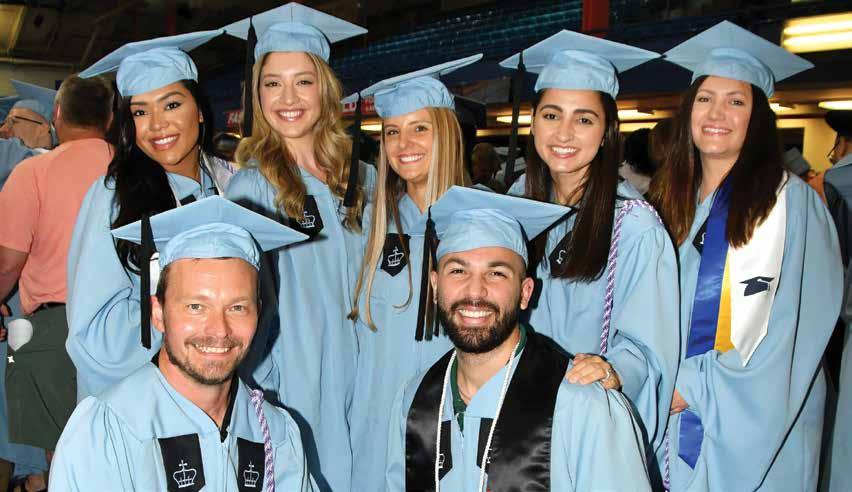
560 West 168th Street, MC 6 New York, NY 10032
“Columbia Nursing has provided me with several opportunities to further my passion for helping serve historically marginalized and underprivileged communities. The financial assistance available through these scholarships helped reduce some of my financial burden and allowed me to focus on my education, leadership, career, and impact on the world. I am a proud Columbia alumna now working as a certified pediatric nurse practitioner in the prestigious Seattle Children’s Advanced Practice Provider Fellowship, serving a diverse pediatric population from across Washington, Wyoming, Alaska, Montana, and Idaho.”
Sumiyah Syed-Uddin, DNP ’22
For more information about giving to Columbia Nursing, visit nursing.columbia.edu/giving or contact Janice Rafferty Grady, assistant dean, Development and Alumni Relations, at 212-305-1088 or jar2272@cumc.columbia.edu.
